Mary Earps is widely thought of as one of, if not the best, goalkeeper in the world at the minute. Her performances throughout England’s successful Euro 2022 campaign saw Earps prove herself on Europe’s biggest stage. In this year’s World Cup, the Manchester United goalkeeper once again raised her game as she won the Golden Glove for some sublime performances which, if we are being completely honest, kept England in the tournament on a couple of occasions.
It has to be said the rise to the top has been a slow one for the Nottingham-born goalkeeper. After coming through Leicester City’s Centre of Excellence, Earps signed for hometown club Nottingham Forest. From there, she went on to play for Doncaster Rovers Belles during the inaugural WSL campaign and the following season.
After some good performances for Doncaster came a move to Birmingham City, who had qualified for the Champions League after finishing second in the 2012 WSL table. Earps found first-team opportunities to be at a premium at St. Andrews, so when the opportunity arose, she put pen to paper for Bristol Academy in 2014.
Following Bristol’s relegation in 2016, a move to Reading was on the cards, where her performances would earn her a place in the PFA Team of the Year for 2016/17. The following season saw Earps spend a year as Wolfsburg’s second-choice goalkeeper.
In 2019, Manchester United came calling with the offer of first-team football, so the then-26-year-old moved back to the WSL. Since signing for the Red Devils, Earps has gone from strength to strength and has not only established herself as England’s number one but proven she can cut it on the biggest stage of all.
With the Women’s Super League season starting soon and Manchester United set to make their Champions League debut, we will look at exactly what makes Mary Earps such a good goalkeeper. In this tactical analysis, we will use data to see how she compares to fellow WSL goalkeepers and use in-game analysis to pinpoint her key attributes in game situations.
What does the data say?
To begin this analysis, we will look at how Mary performs in specific metrics compared to her WSL peers.
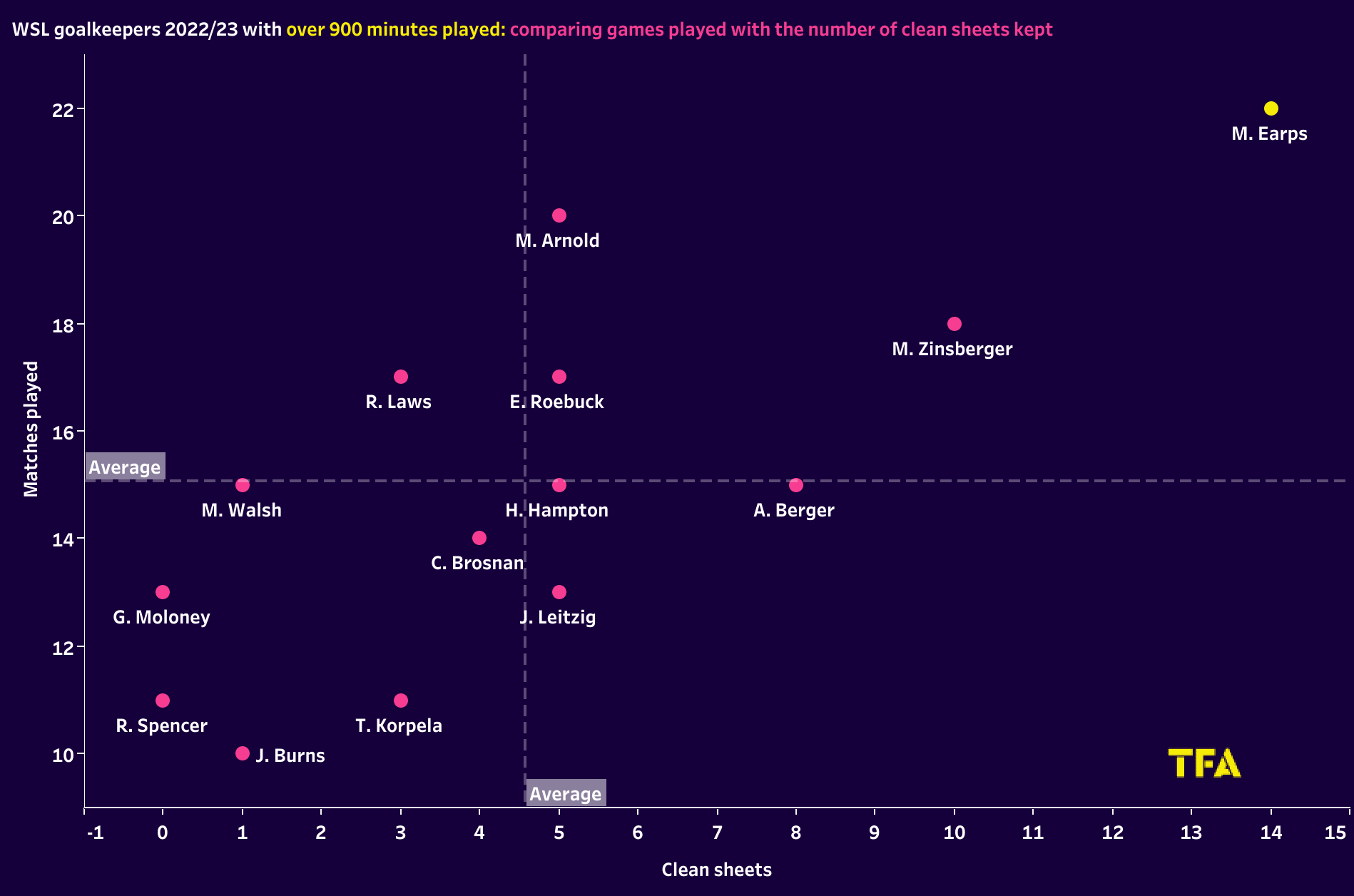
The sample for the data comparison in this scout report consists of goalkeepers in the WSL who played over 900 minutes of football last season. From the data visual above, we can see that Earps played in all of Manchester United’s 22 league games last season, where she kept a remarkable 14 clean sheets.
The only thing we can glean from these metrics is that Mary kept the highest number of clean sheets. However, given the amount of game time, we must acknowledge that she had more opportunities to do so.
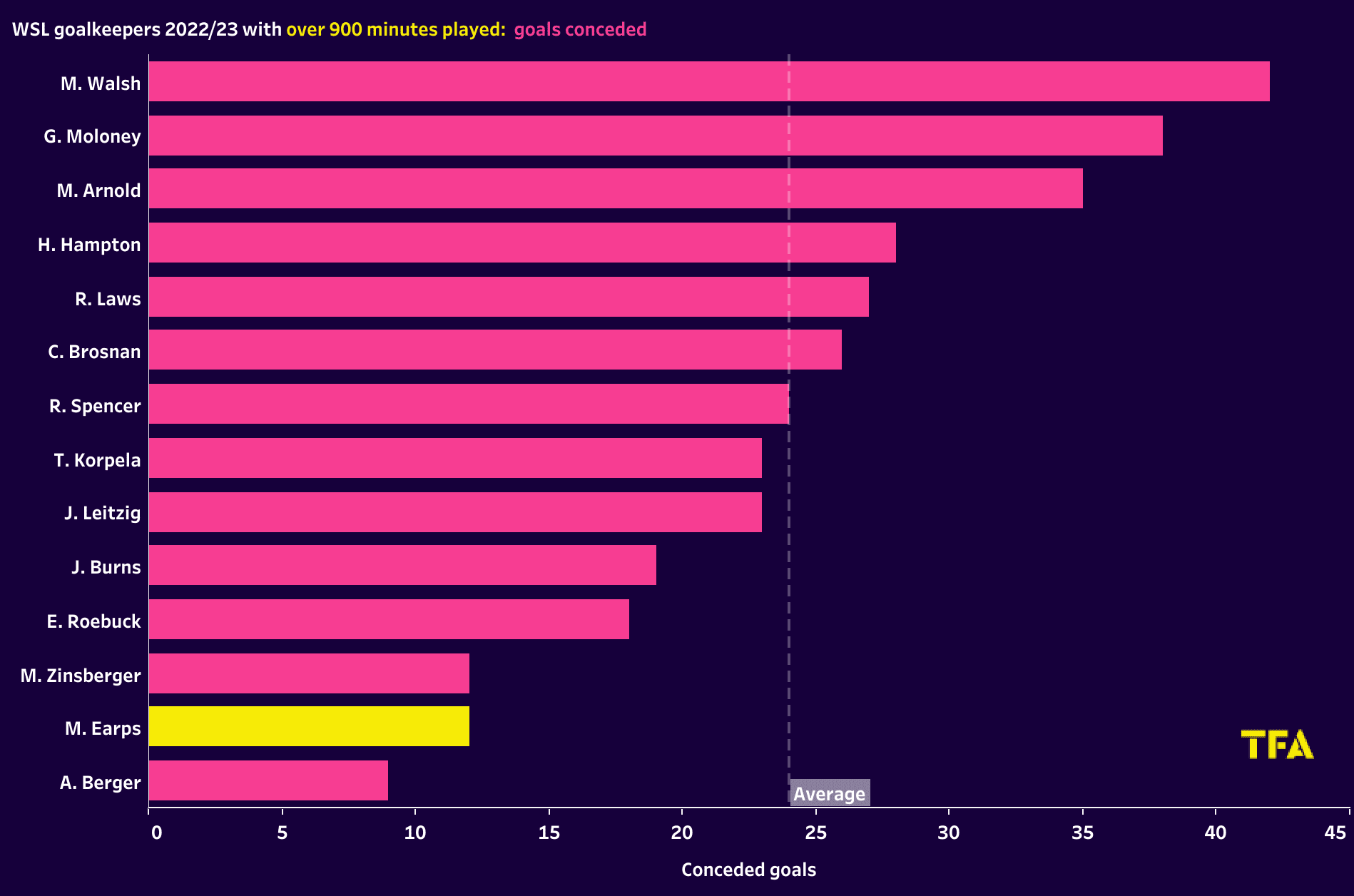
Here, we can infer that Earps conceded the second-least amount of goals throughout the season. The Man United stopper let in 12 goals from her 22 games, a statistic which sees her on a par with Arsenal’s Manu Zinsberger. The only goalkeeper to concede fewer goals was Ann-Katrin Berger of Chelsea. However, it is worth noting that Berger recorded 1462 minutes played compared to Zinsberger’s 1769 and Earps’ 2168.
Therefore, if we look at goals conceded per 90 in the chart below, we can see that Mary Earps conceded 0.5 goals per 90 minutes. In comparison, Berger conceded 0.55 per 90 and Zinsberger, 0.61.
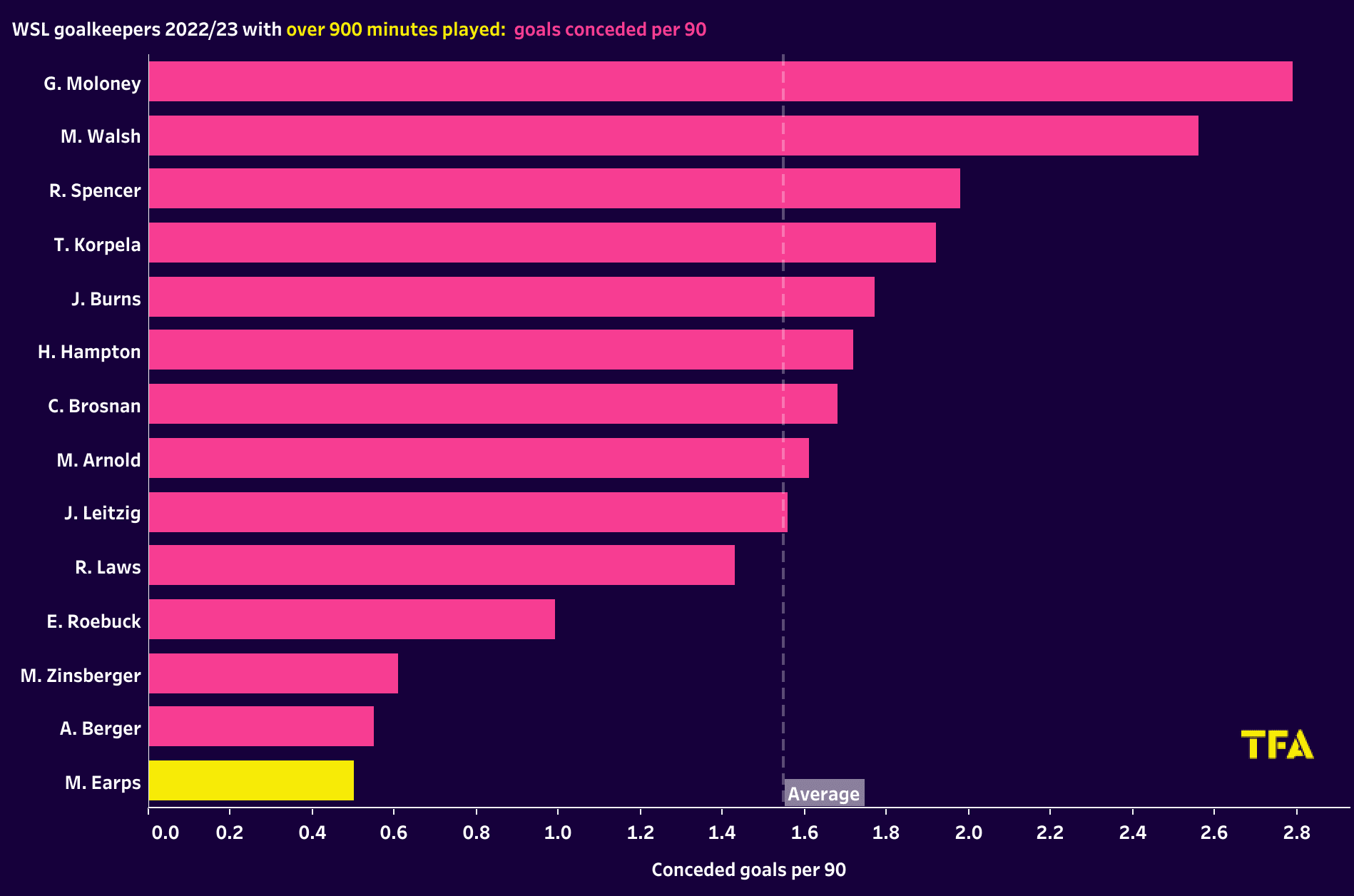
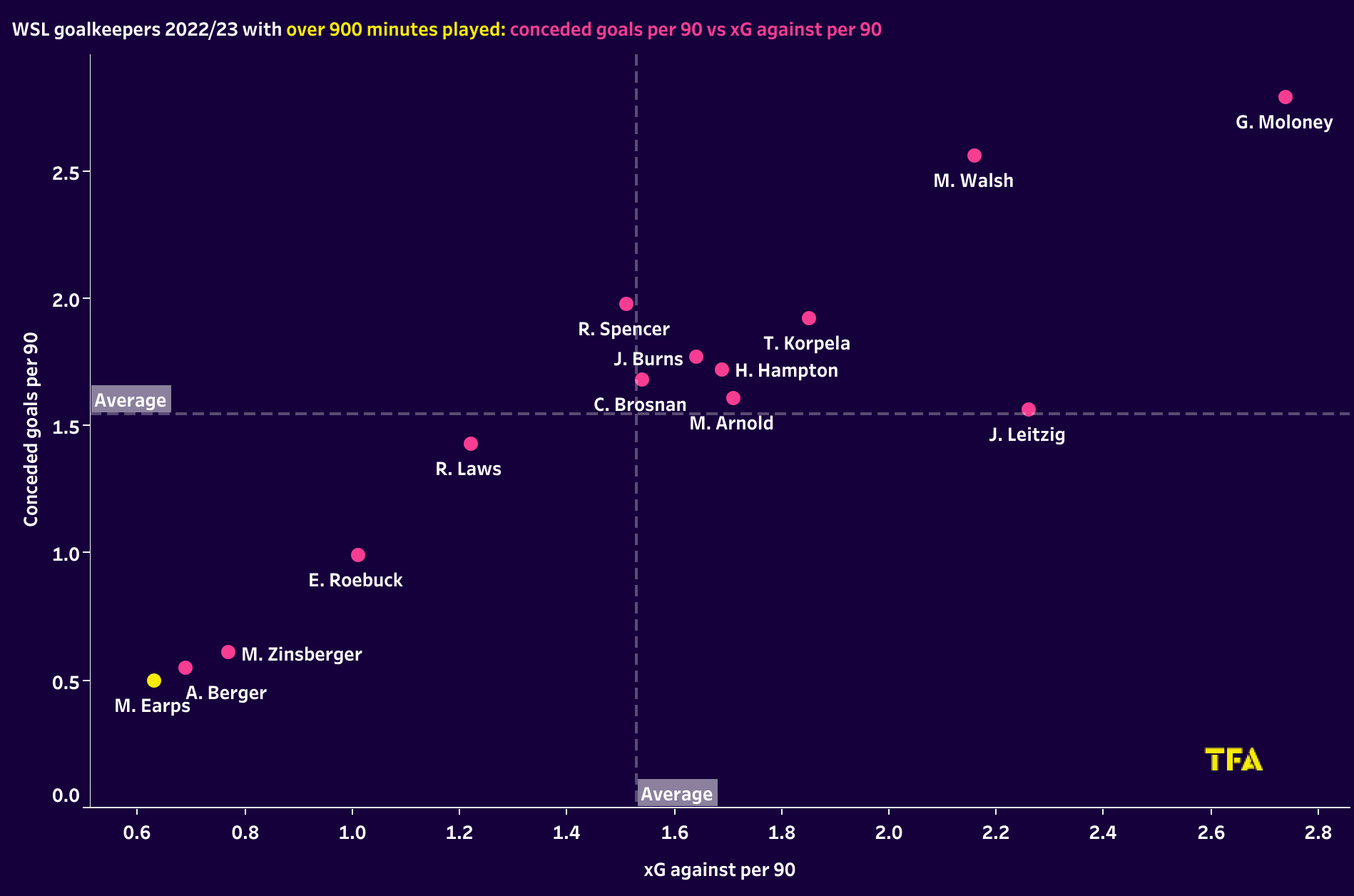
Furthermore, we can see that Earps’ 0.5 conceded goals per 90 came from 0.63 xG against per 90. From this, we can infer that England’s number one conceded slightly fewer goals per 90 than ‘expected’. However, many factors influence the metric of xG against per 90.
The role of Manchester United’s defensive unit as a whole is something to consider. ‘XG against’ is the expected number of goals from the opposition based on the quality of the opportunities. We have to accept that there are many factors which influence the quality of chances conceded by Manchester United.
A good example is defensive positioning; the defenders work hard to use their positioning and body orientation to narrow angles and limit space to prevent opponents from having an easy shot, which, in turn, impacts the number and quality of opportunities the opposing team can create.
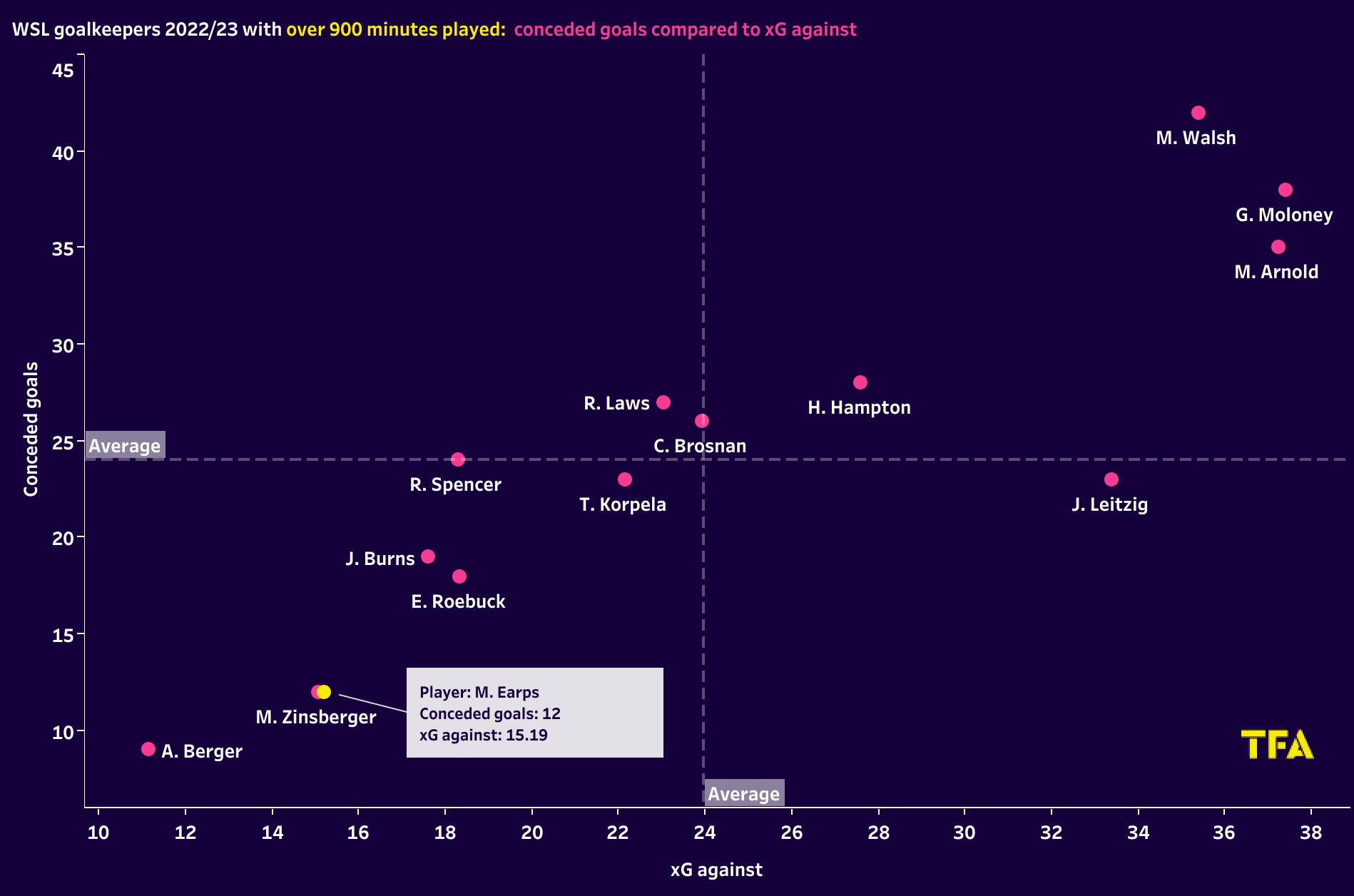
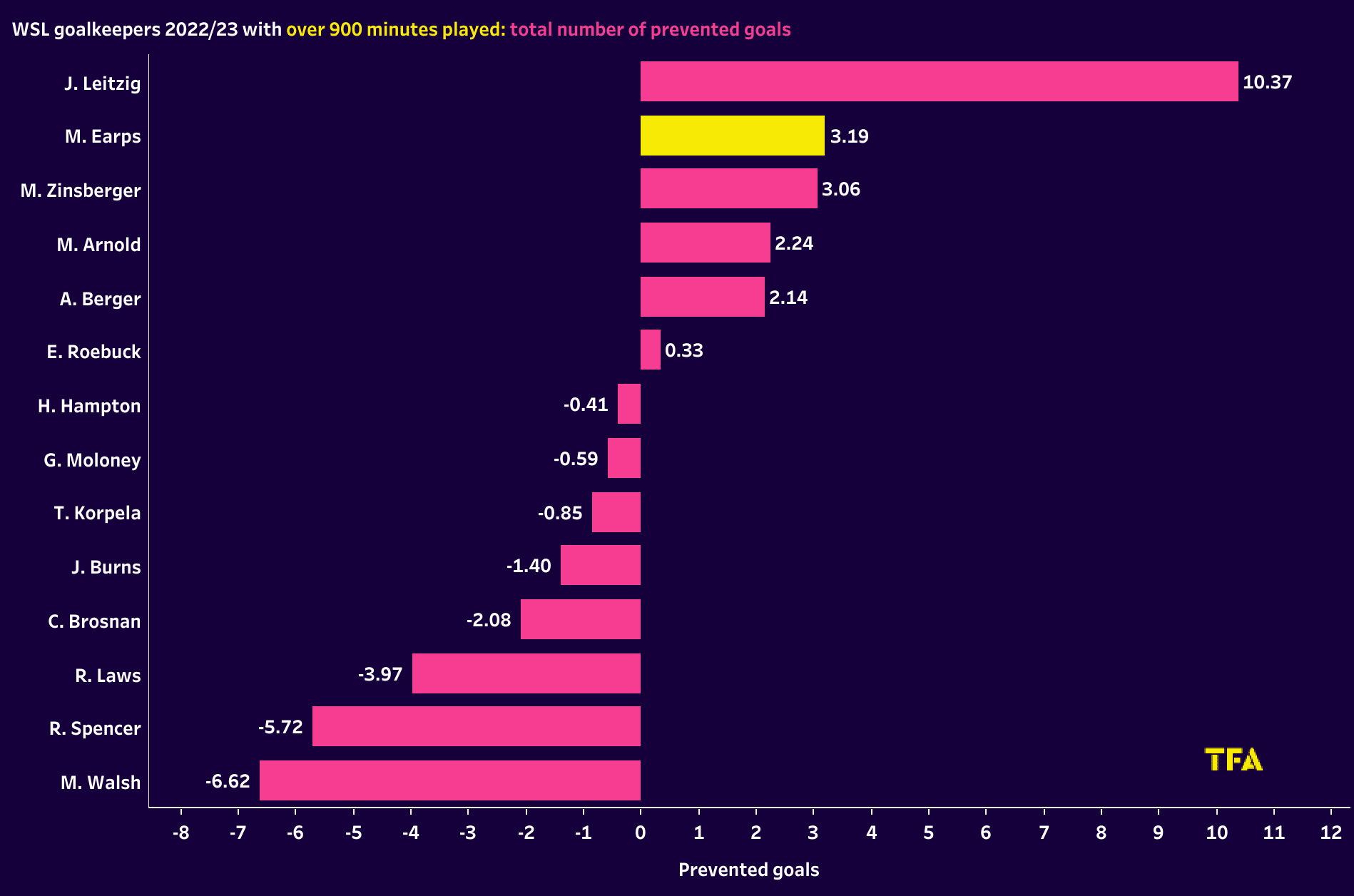
A better way of assessing her impact on Manchester United’s performances is to look at the number of goals she had prevented. We have already established that throughout 22 games, Earps conceded 12 goals from an xG against of 15.19 as per the data viz above. Therefore, we can understand that she prevented a total of 3.19 goals during the 2022/23 campaign.
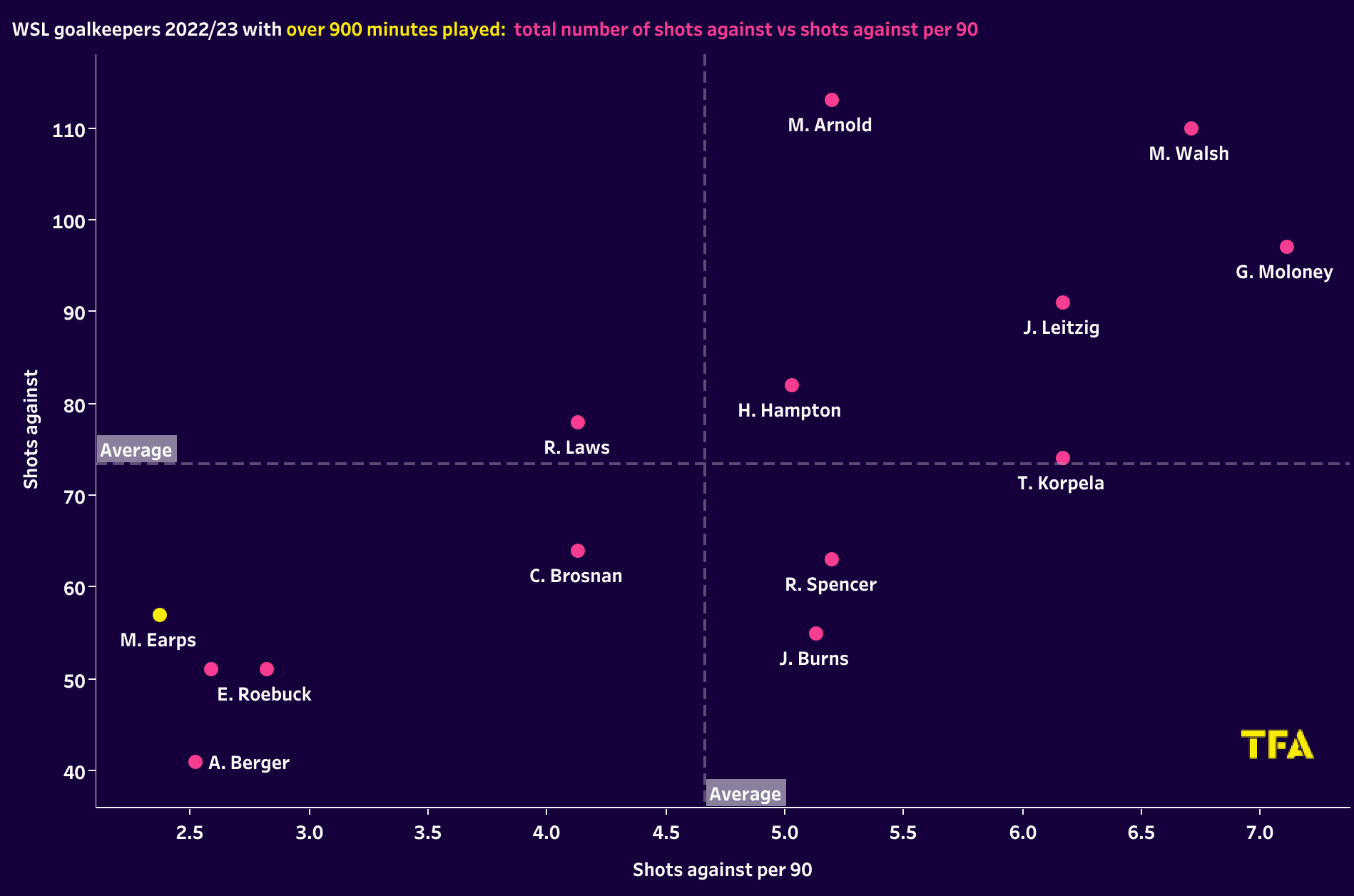
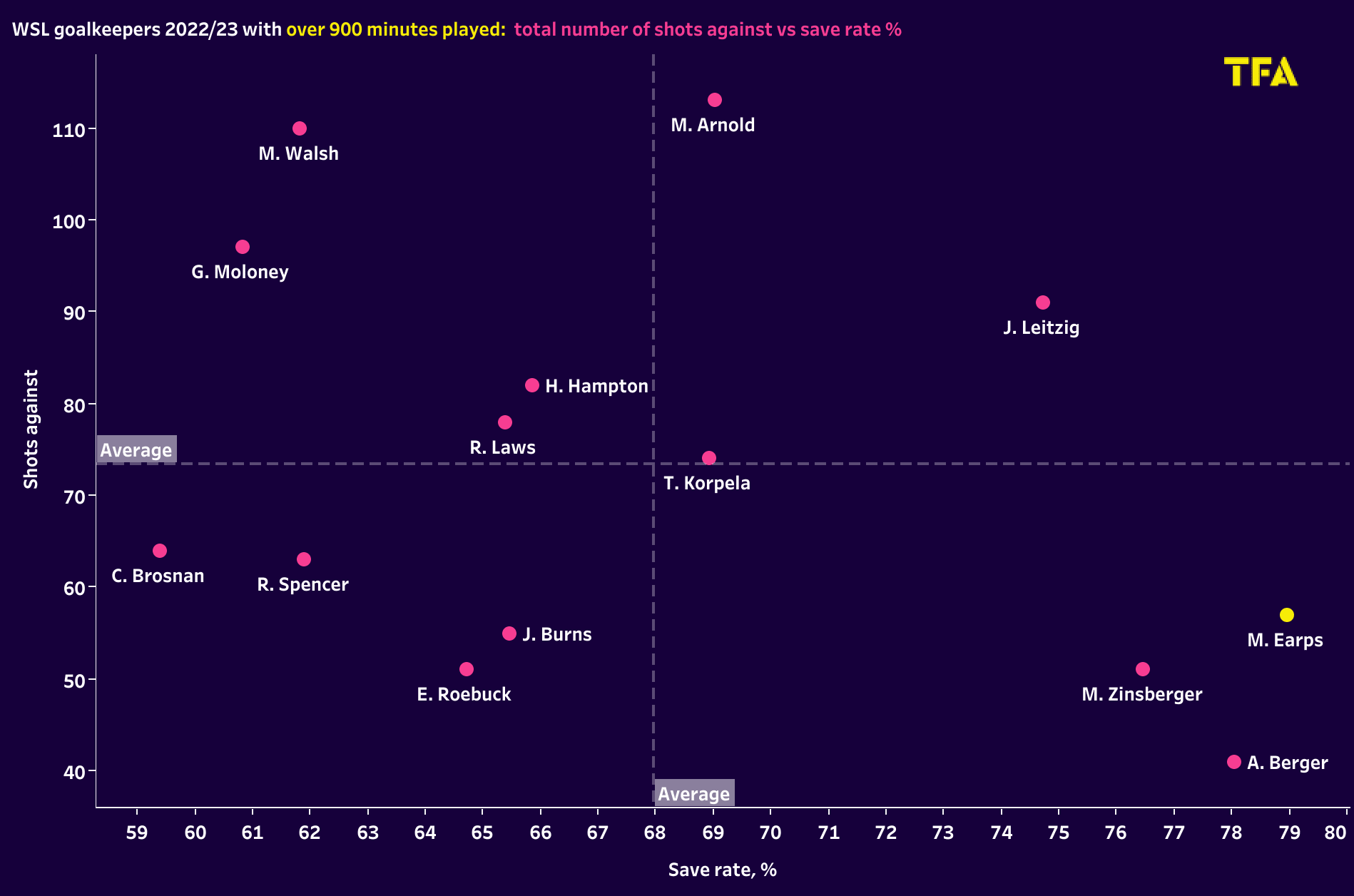
Additionally, from the two data visuals above, we can see that Mary Earps faced a total of 57 shots last season. More than Zinsberger, Roebuck and Berger. However, because she played a higher number of games, this translates to 2.37 shots against per 90. Plus, according to the second data visual, Earps saved 78.95% of the shots against her, giving her the highest save rate percentage in the league.
The shot-stopper
Mary Earps is an excellent shot-stopper. As we know, she faced 2.37 shots per 90 during the 2022/23 campaign. Of those, she saved 1.87 per 90, using her reflexes 44.4% of the time.
She can position herself well to quickly move across the goal, which allows her to narrow the angle for the opposition attacker. Narrowing the angles makes it considerably more challenging for the opposing striker to find the back of the net. By angling her body in a way that reduces the visible target, Earps effectively reduces the available space for the striker to aim at.
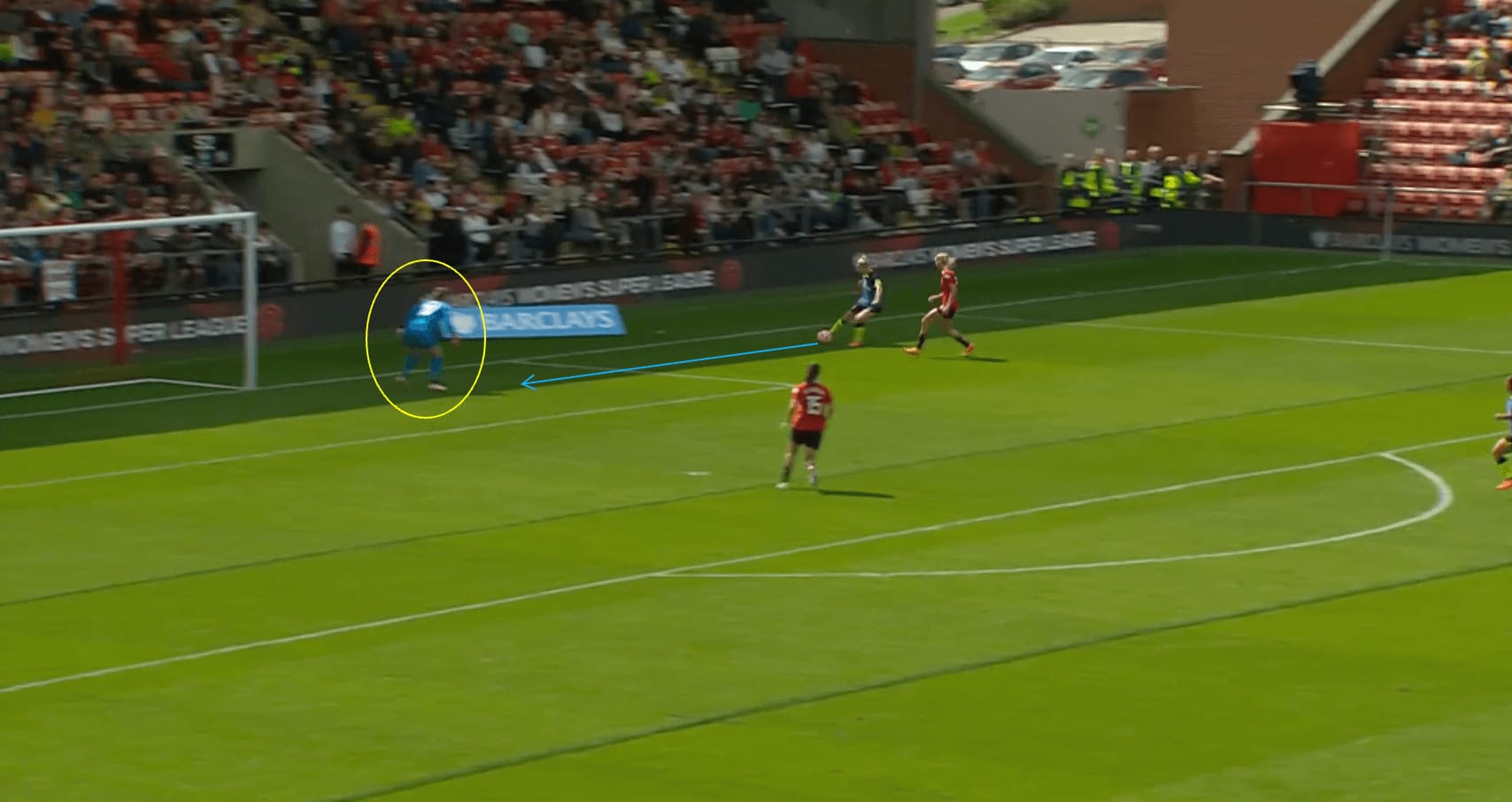
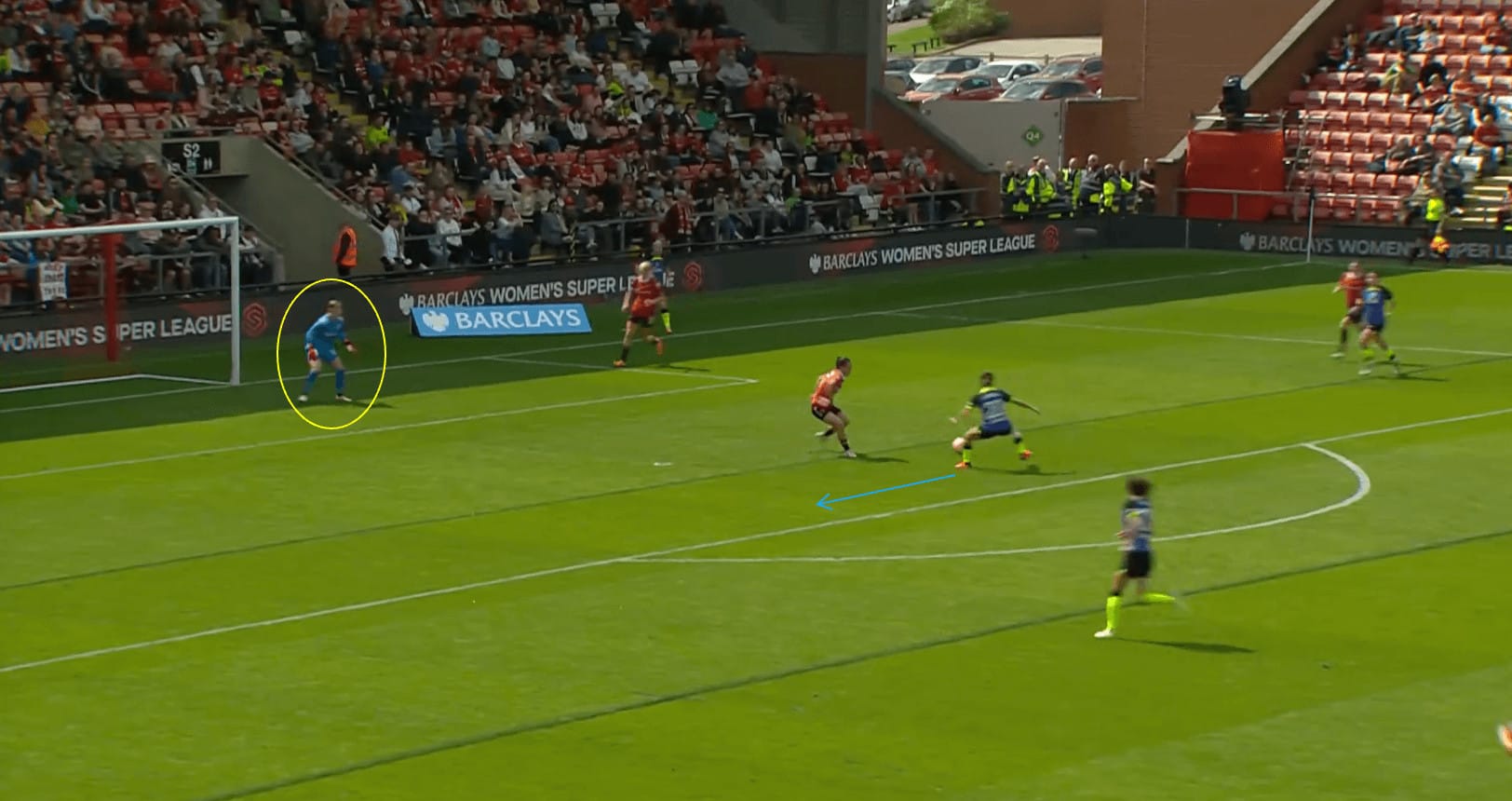
In the scenario depicted above, we can see that the Man United goalkeeper closes down the angle at her near post, which prevents Tottenham Hotspur forward Bethany England from being able to get a shot on goal.
Instead, England pulls the ball back to her teammate, who easily outmanoeuvres her opponent with a nice side step. Earps has to adjust her position quickly; as we can see below, she moves forward to the edge of her six-yard box (it is rare to see Mary Earps actually leave the six-yard area; most of her ‘saving’ actions occur in the area).
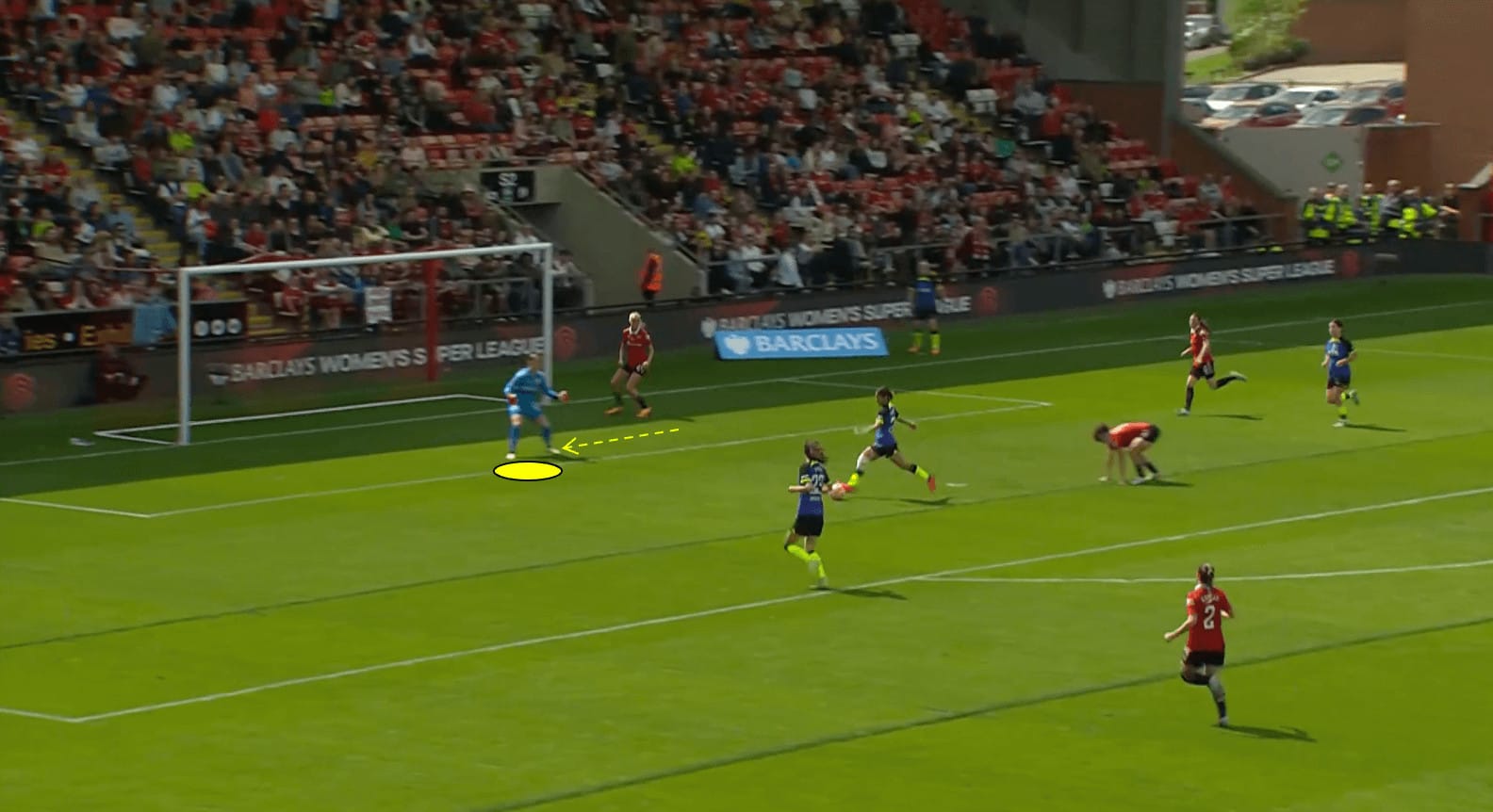
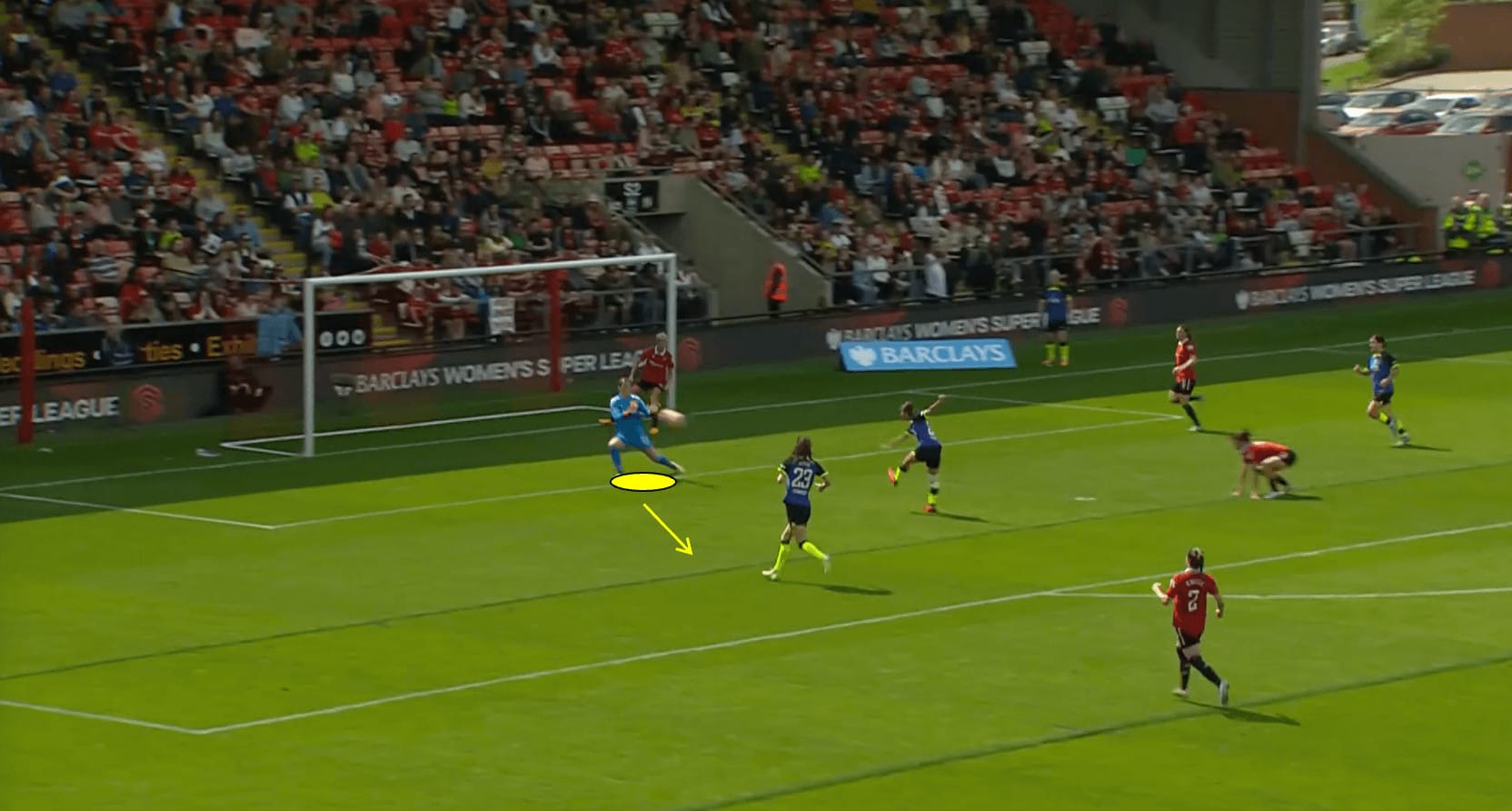
Earps then makes herself as big as possible to narrow the available angles. In this scenario, the shot is poor and straight at her, but she reacts quickly to parry the ball away.
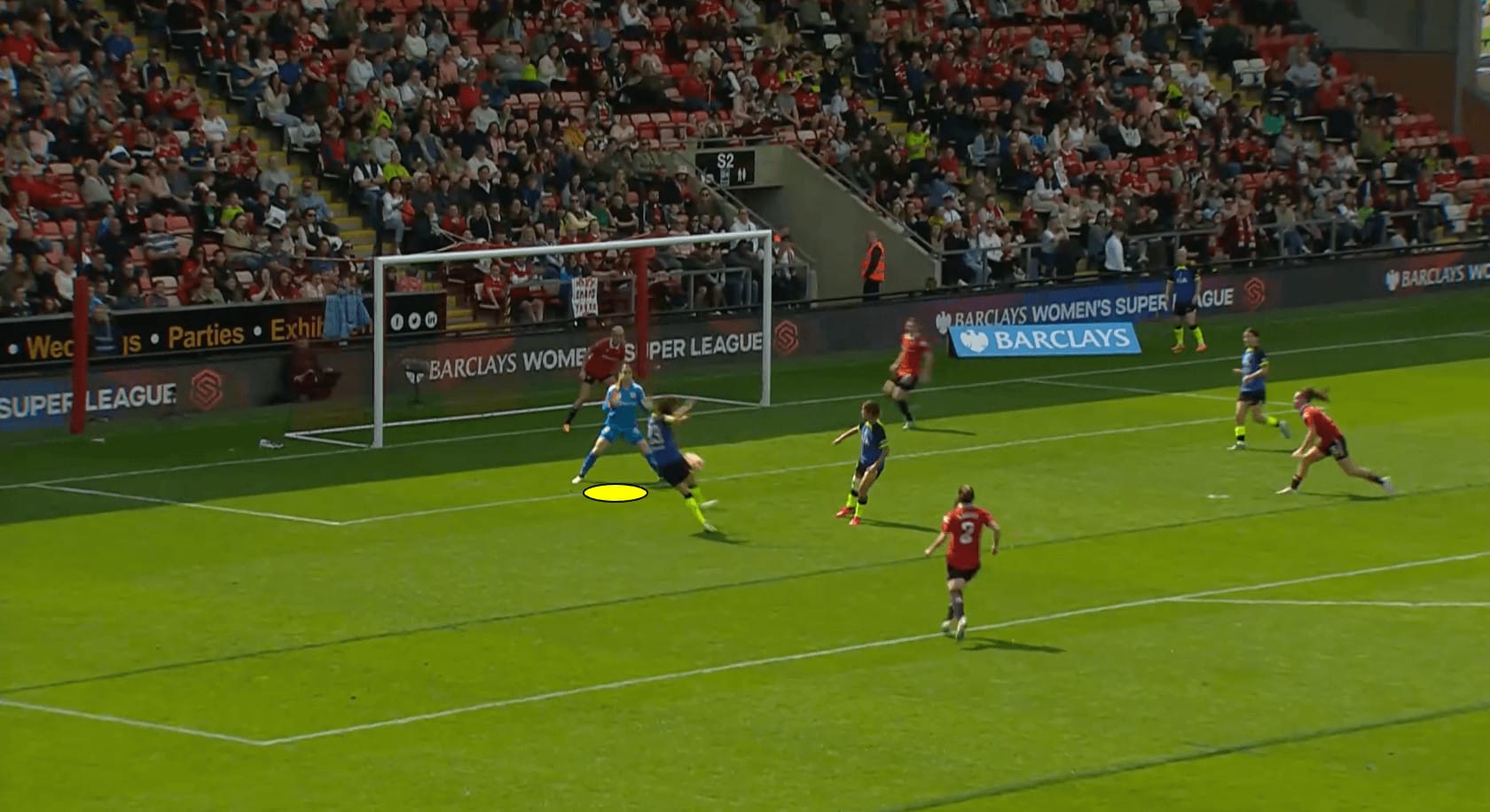
On this occasion, the parry is not controlled well and lands at the feet of another Tottenham player. However, Earps displays excellent speed and awareness to get up quickly and once again make herself as big as possible. This time, she makes the save and parries the ball away, putting it out for a corner.
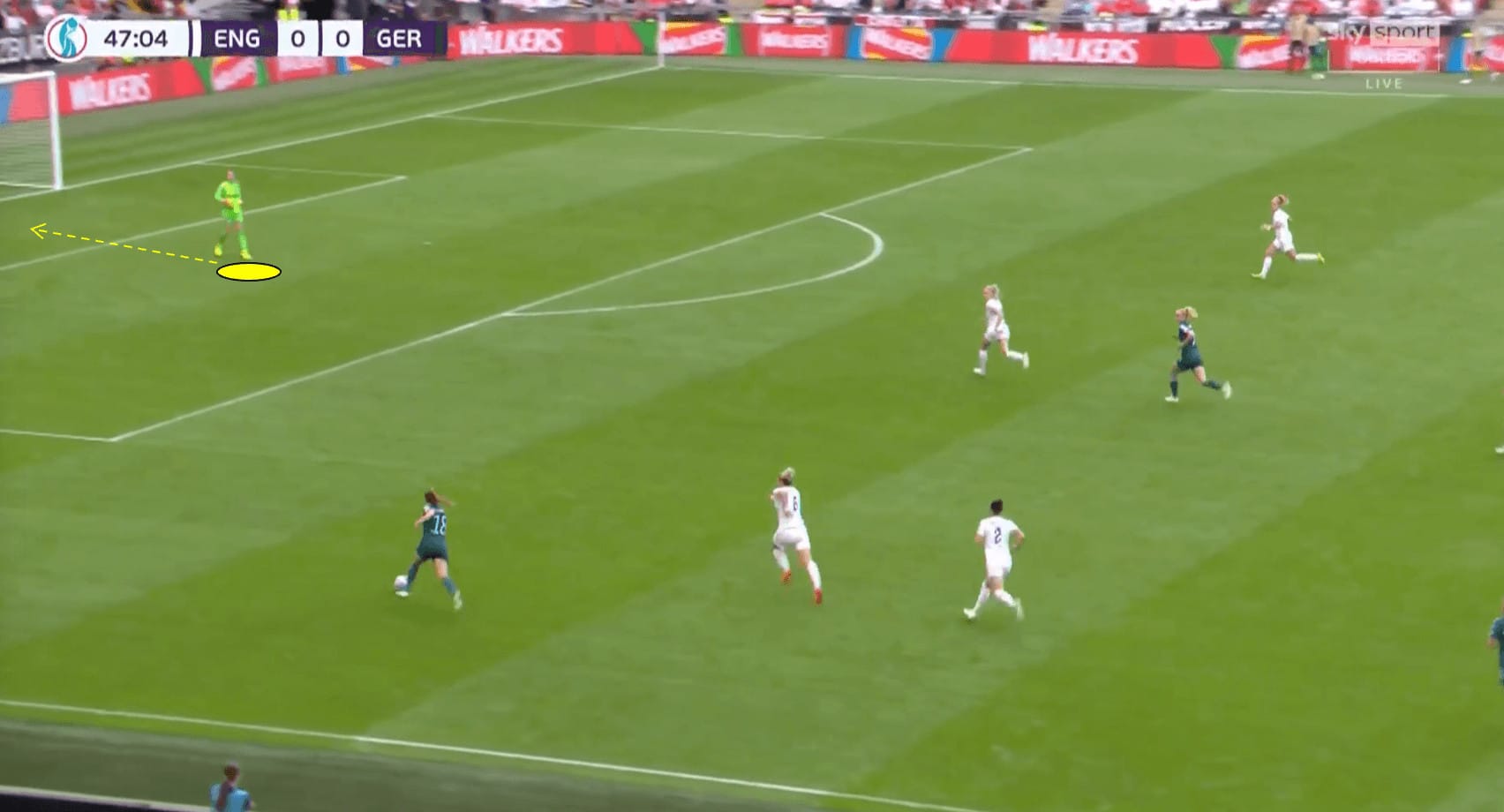
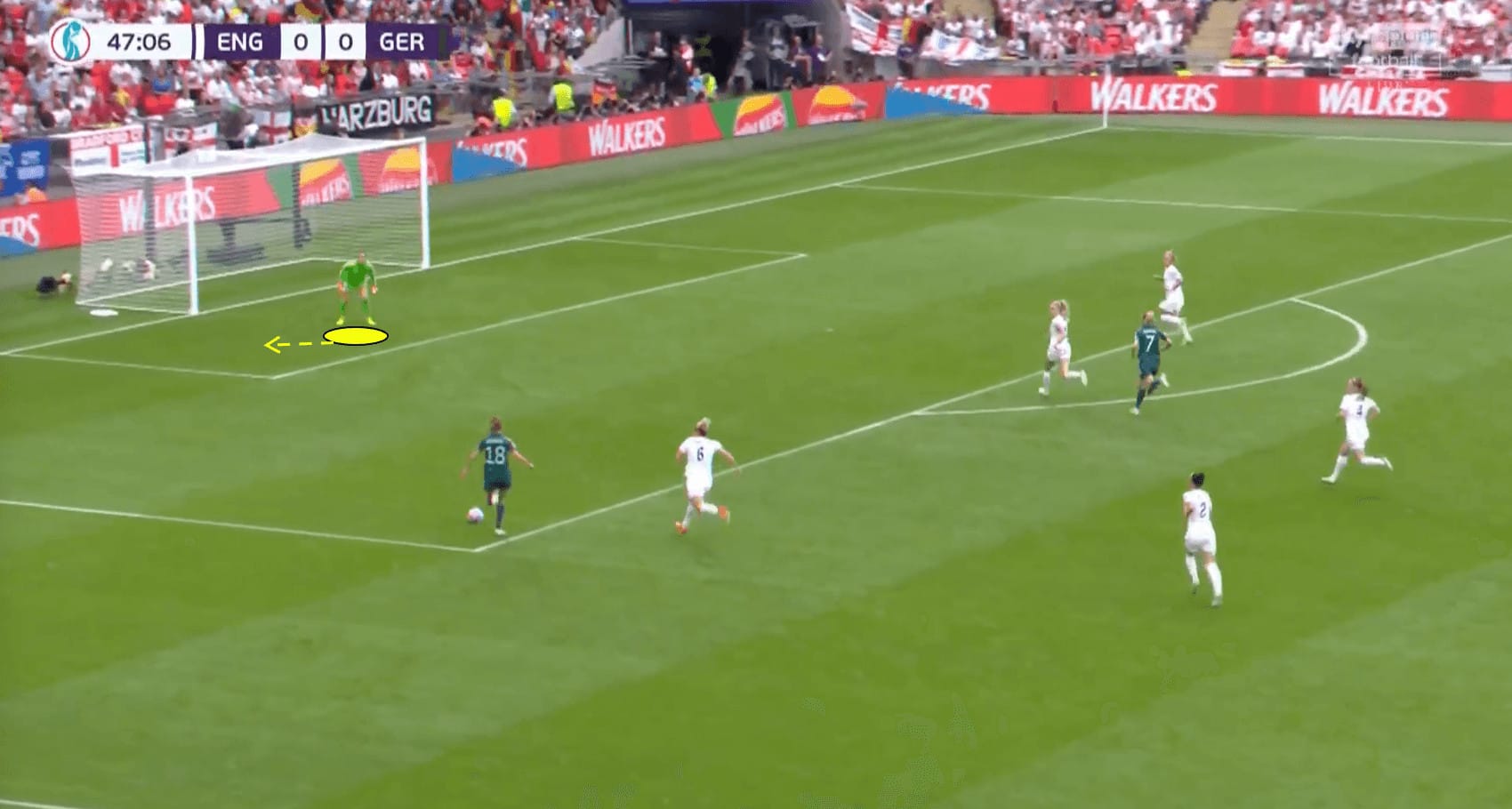
Another excellent example of the movement and positioning that is a critical element of Mary Earps’ shot-stopping ability can be seen here. With Germany on the counterattack, she begins to move backwards towards her goal line, already limiting the angle available to the attacker.
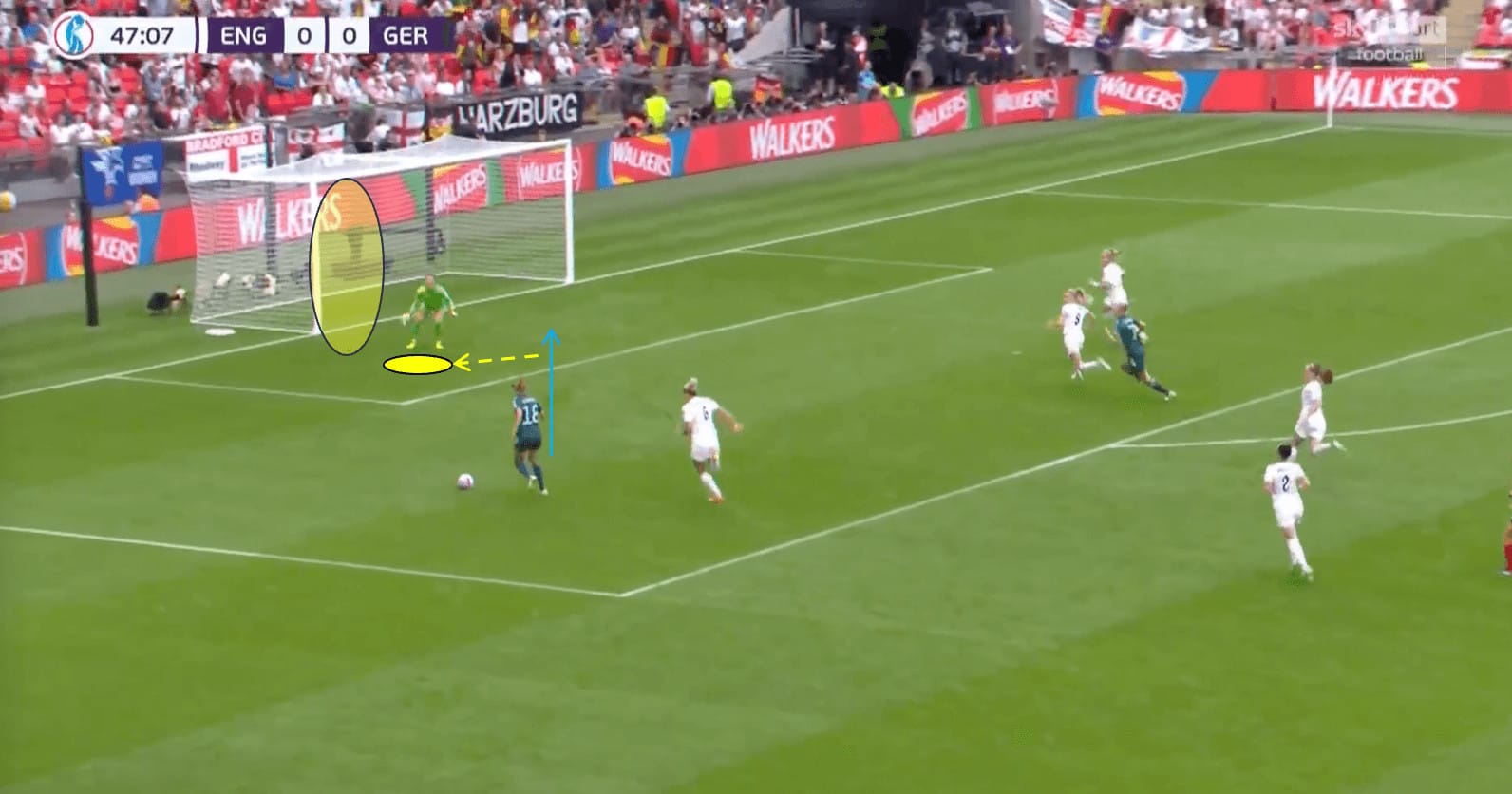
Next, she makes a very subtle but crucial step to her right, which closes off the angle at the near post even more, meaning it would have to be an extraordinarily well-executed and accurate shot to hit the back of the net.
By narrowing the angle, it minimises the time she needs to react to the shot. This reduces the need for rapid, acrobatic saves and allows her to rely more on positioning, which is both less physically demanding and more reliable throughout a match.
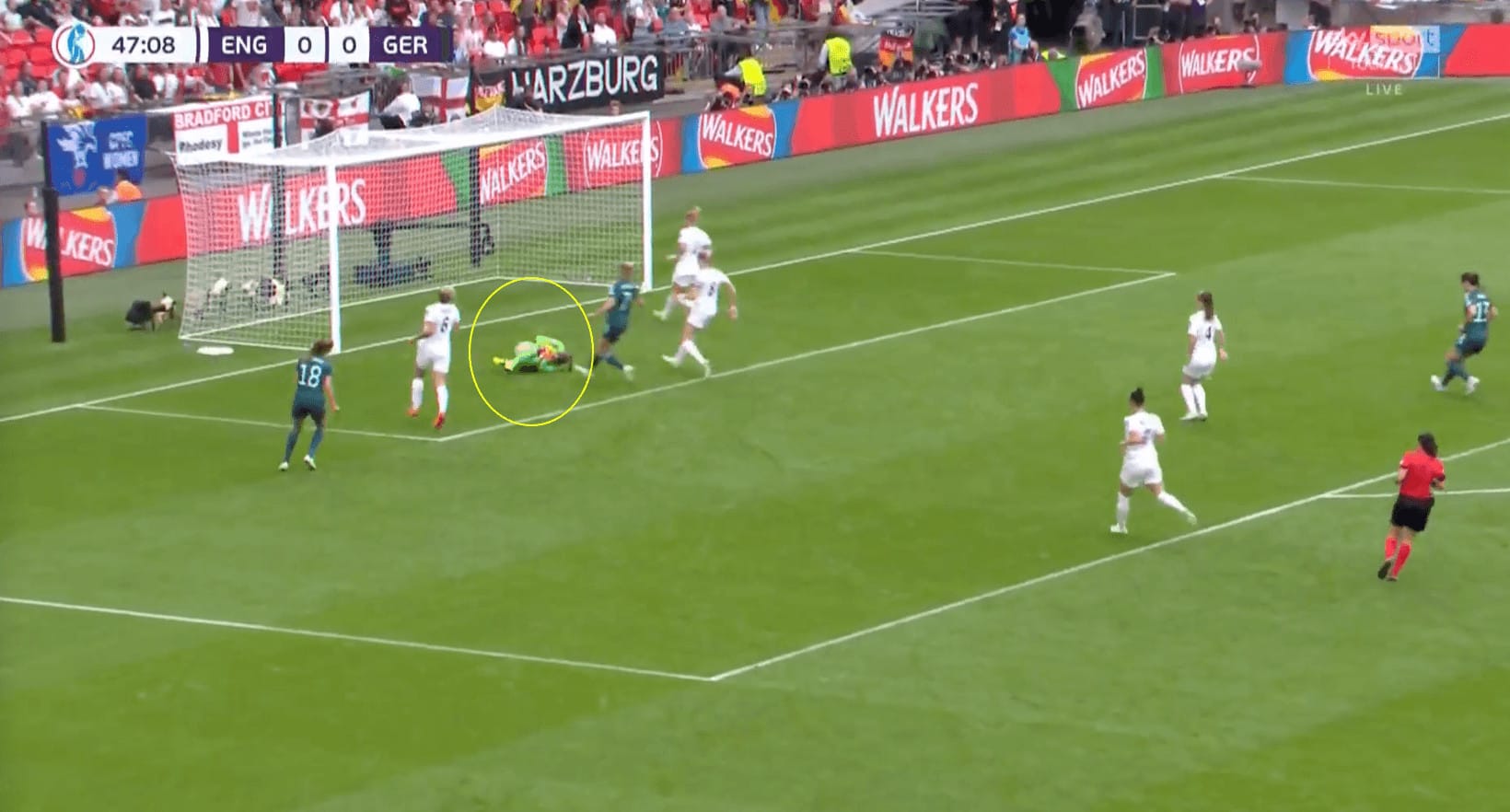
With no other option, the German attacker shoots towards the far post, but Earps gets down quickly and collects the ball, using her body to ensure she retains a tight grip and that it does not spill out of her hands and fall at the feet of an opponent.
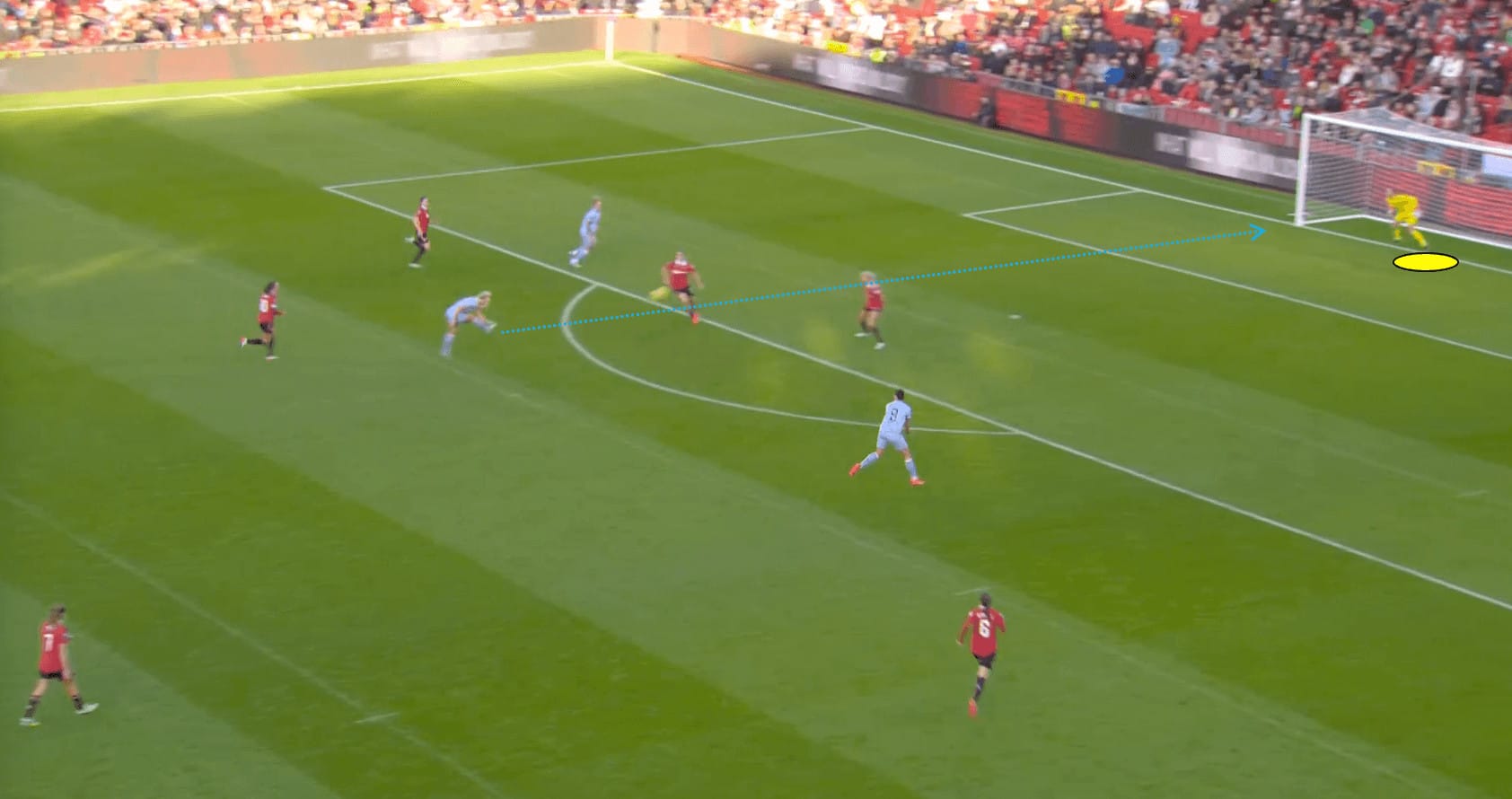
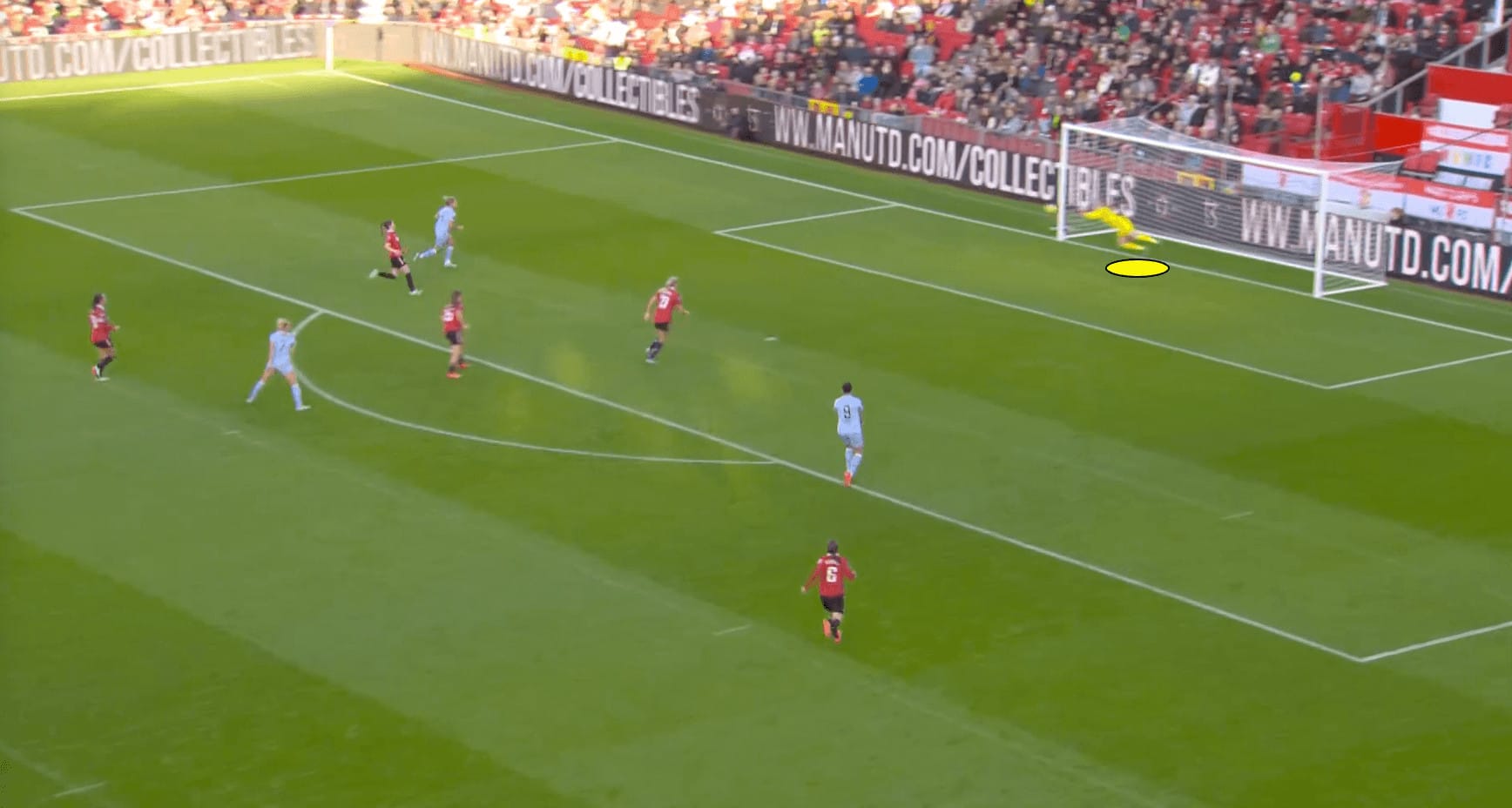
Moreover, when dealing with long shots, Earps will stay on her line as it allows her time to assess the trajectory of the shot so she can ensure she has optimal positioning in order to make the save.
Here, she is in a good position, slightly nearer to the post where she believes the shot will be aimed. However, she is not too far over that she cannot quickly readjust and move across her goal line if needed. She pushes off with her right foot, which generates the power she needs to get across to the near post and palm the ball out for a corner.

Furthermore, the Nottingham-born goalkeeper is very competent when using her legs to make a save. As we can see above, Sam Kerr is through on goal, and between them, Hannah Blundell and Earps ensure that the angles are limited.

The defender’s positioning means Kerr has to take a touch to move the ball away from her, whilst the positioning of Earps means the best option for Kerr is to hit an angled shot at the far corner. The goalkeeper demonstrates that she is able to get down quickly and adjust her body positioning to block the shot with her left leg.
Aerial abilities
Now, let’s turn our attention to how well she does in terms of aerial command. So, why do goalkeepers need to be proficient aerially? First and foremost, strong aerial command allows the goalkeeper to confidently come off their line to claim or punch away high crosses and corner kicks. By doing so, they can prevent dangerous scoring opportunities for the opposing team. This proactive approach reduces the likelihood of opponents winning headers in the box or scoring from close range.
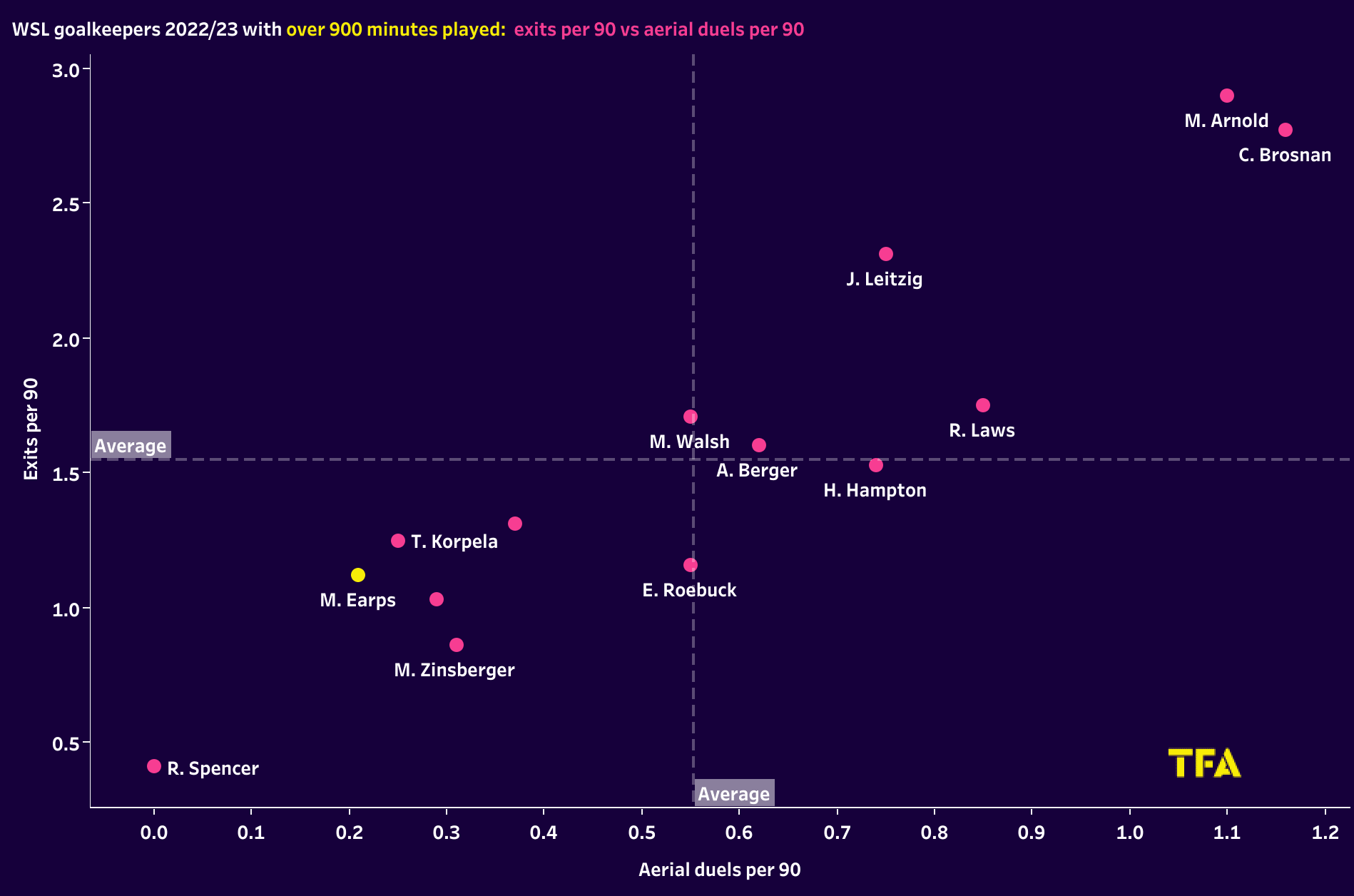
When dealing with aerial threats, Mary Earps is very decisive. We can see from the visual above that she averages 1.12 exits per 90 – the definition of an ‘exit’ is ‘the number of events leaving the line’ such as ‘an attempt from the goalkeeper to claim a cross by punching or collecting the ball’. However, when there is a challenge from an opposition player, this is an aerial duel.
The 30-year-old does not often leave her line to collect the ball unchallenged, preferring to trust her defence to do their job and clear their lines. Additionally, during last season, Manchester United averaged 62.71% possession; therefore, there were fewer opportunities for opponents to attack, ultimately leading to fewer goalkeeping actions, such as collecting a high pass or cross, being required.
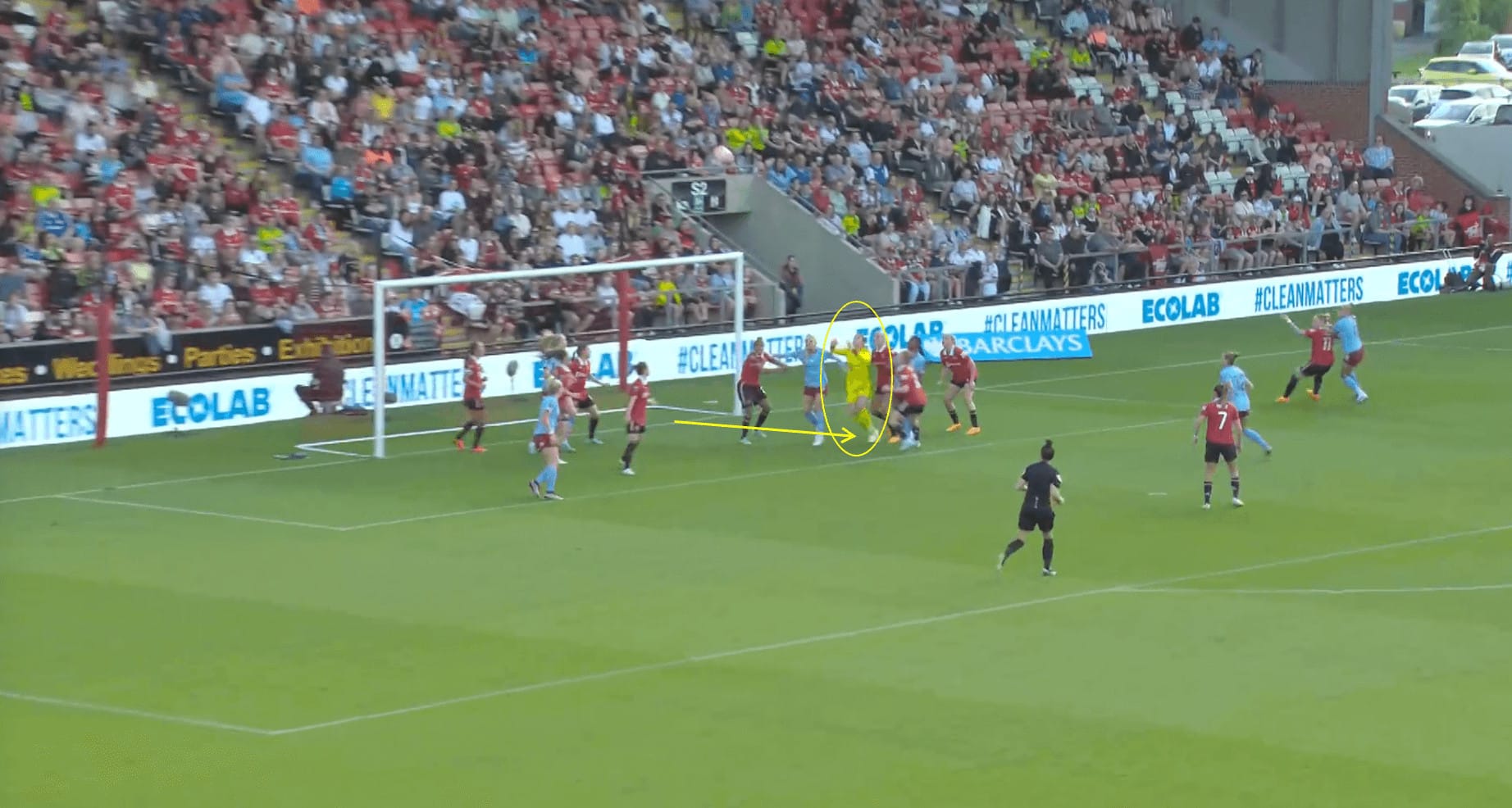
We can see here that Earps is confident when she does come off her line and watches the ball despite the players surrounding her. In this scenario, she remains rooted to the ground until the ball is on a downward trajectory. Then, she calmly reaches above the surrounding players to collect the ball.
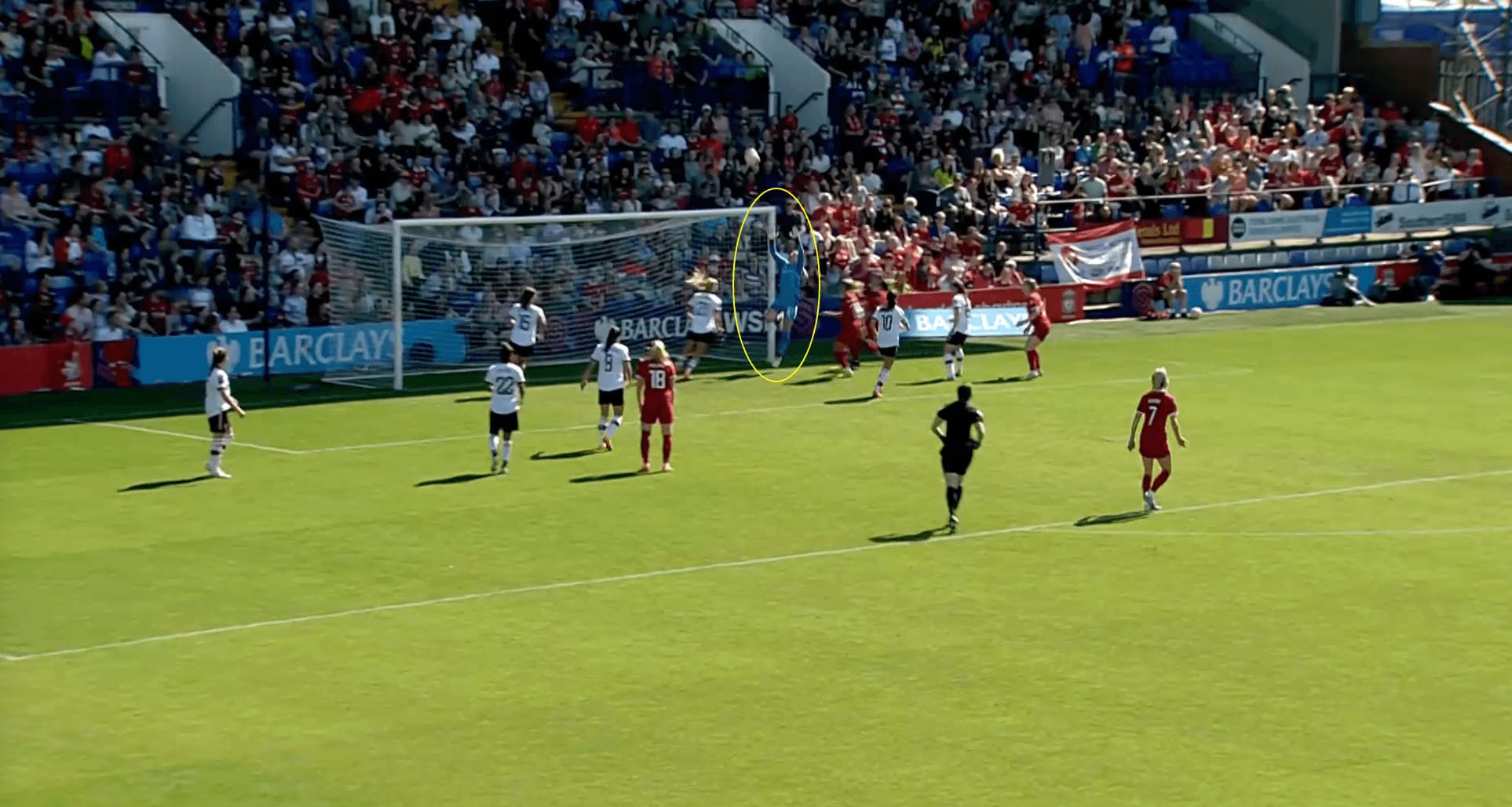
Moreover, since she is often reluctant to leave her goal line, it offers teams the potential to put her under pressure. This is something that she deals with well. She demonstrates an excellent ability to judge the flight of the ball as well as a commanding presence in the air. Earps generates good power to jump high enough to claim the ball and shows good handling to retain hold of possession in the air.
Distribution
Goalkeepers with good distribution abilities can provide their teammates with passes that suit the specific situation. Whether it’s a precise short pass to maintain possession or a long, strategic clearance to clear their lines, a goalkeeper’s ability to adapt their distribution to the needs of the moment is invaluable in dictating the tempo and flow of the game.
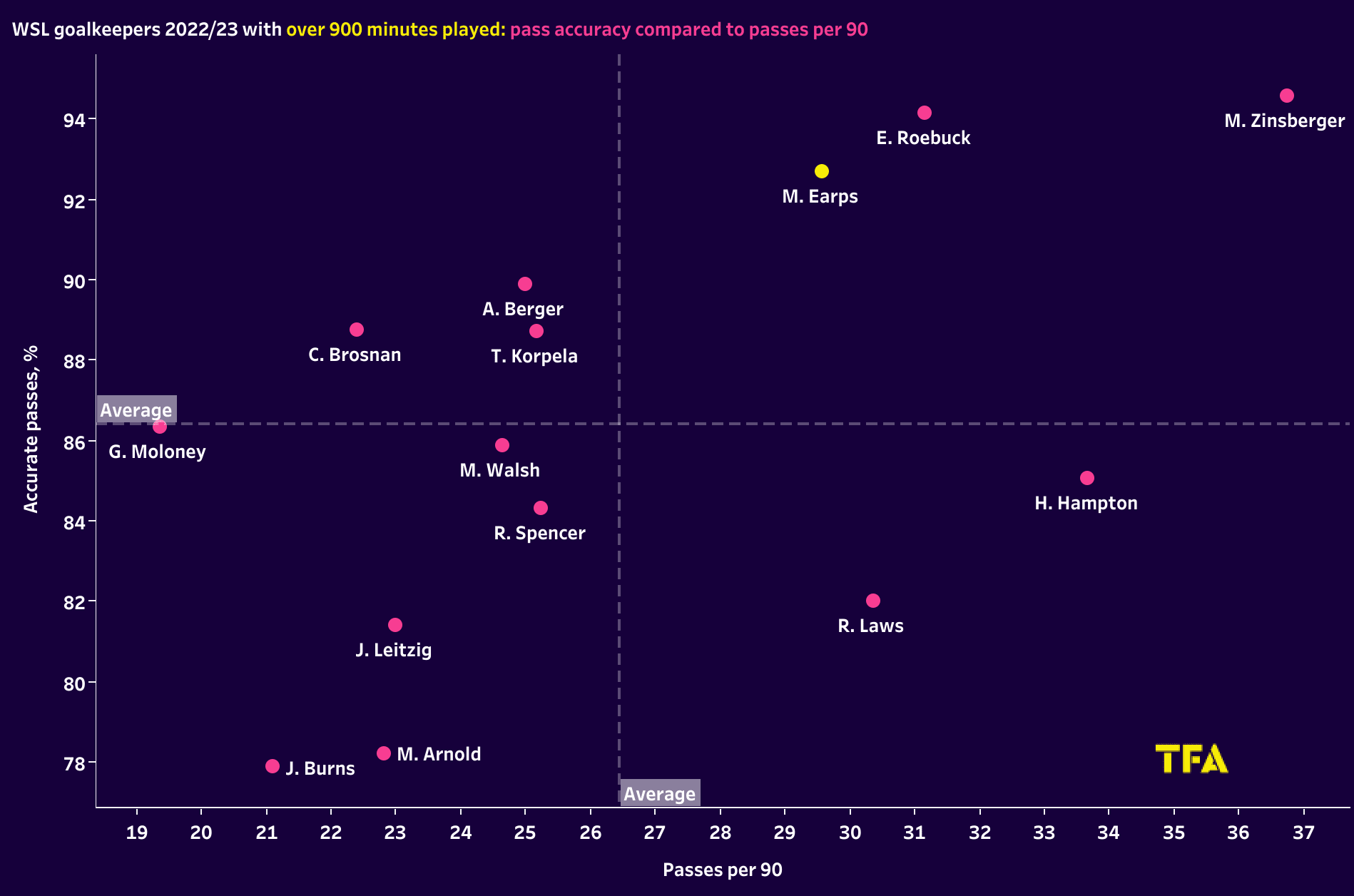
This data visual tells us that Earps averaged 29.96 passes per 90 during the 22/23 season, with an accuracy rating of 92.7% – the third highest in the league (behind Zinsberger and Roebuck of Arsenal and Manchester City, respectively). This statistic is quite remarkable, considering this includes short-medium and long passes.
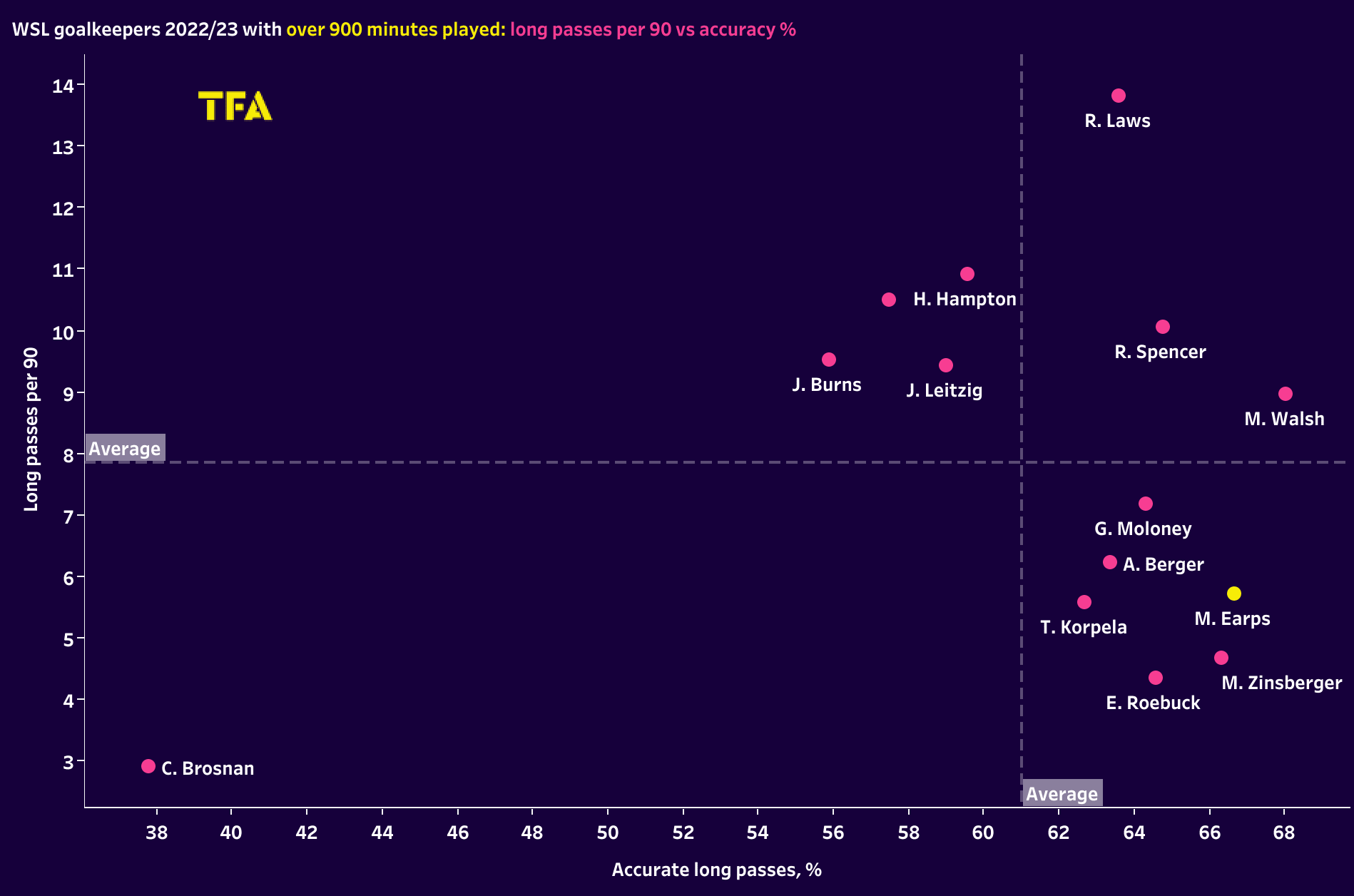
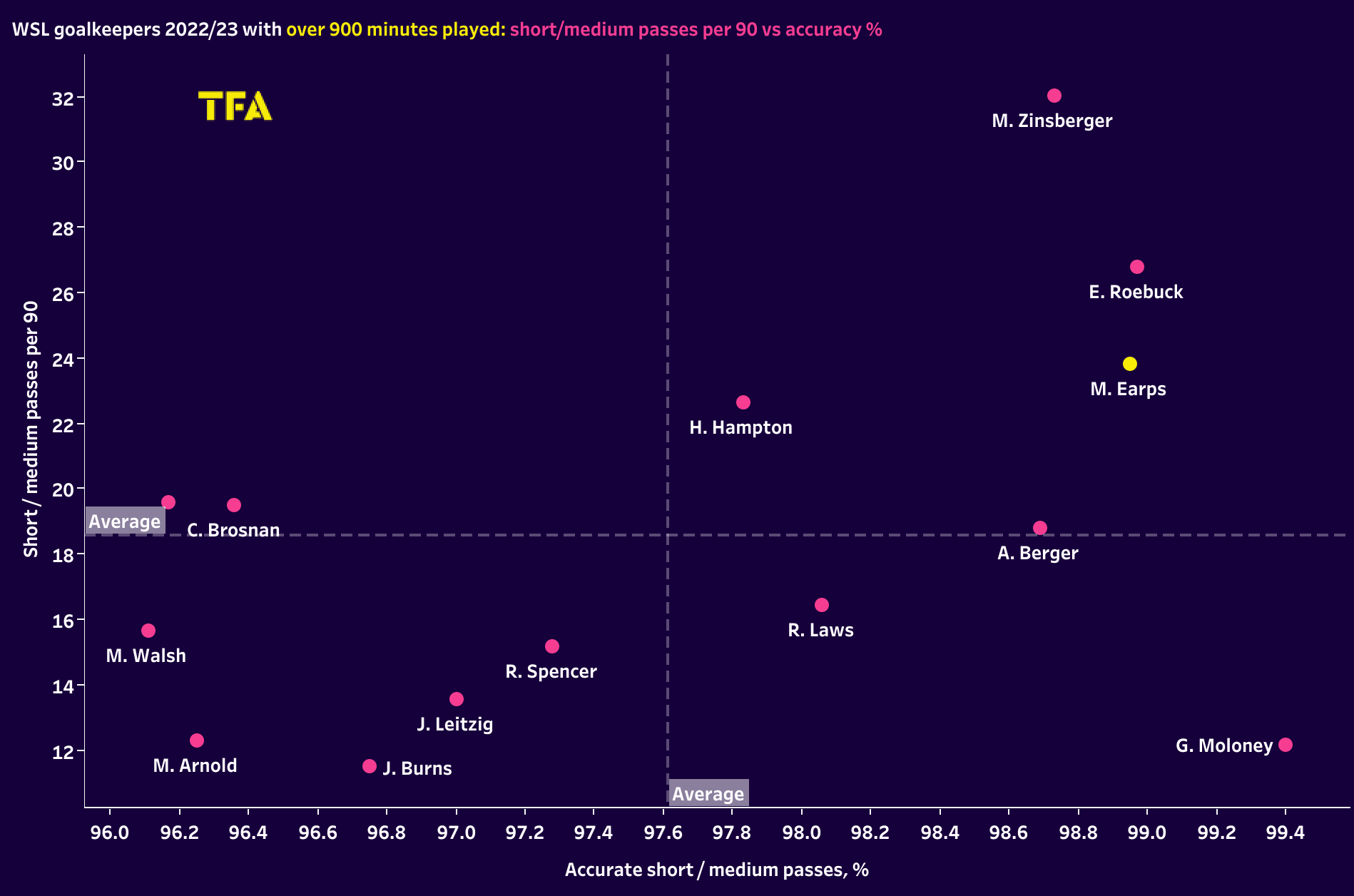
Analysing the passing data in more detail, we can see that Mary Earps averaged 5.73 long passes per 90, with an accuracy rating of 66.67%. Based on this, we can infer that the number of long passes she executed per 90 was below average but also in keeping with Marc Skinner’s desire to play a possession-based style.
However, she was above average in terms of her accuracy rating, which tells us she is capable of picking out a teammate well. Of course, the pass’ accuracy depends on said teammate’s ability to control the ball and the opponent’s ability to intercept the pass.
Additionally, Earps was incredibly reliable with her short-medium range passing as well. Averaging 23.83 short-medium passes, with an accuracy rating of 98.95%.
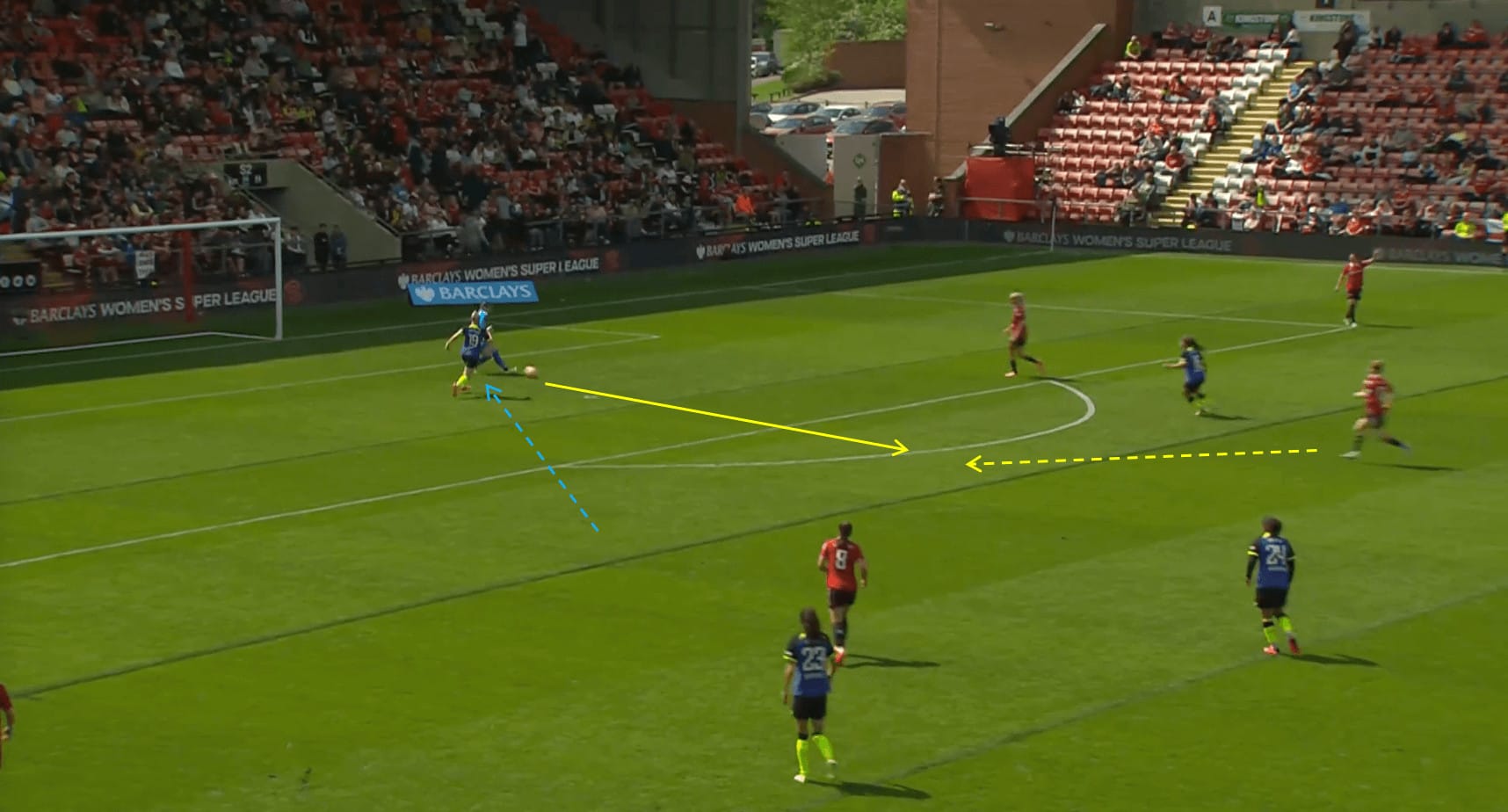
We can see how well the Manchester United goalkeeper does under pressure here. She stays very calm and composed on the ball and looks to play a pass to a teammate. After playing the pass, Earps then moves to ensure she is open should her teammate look to play the return pass.
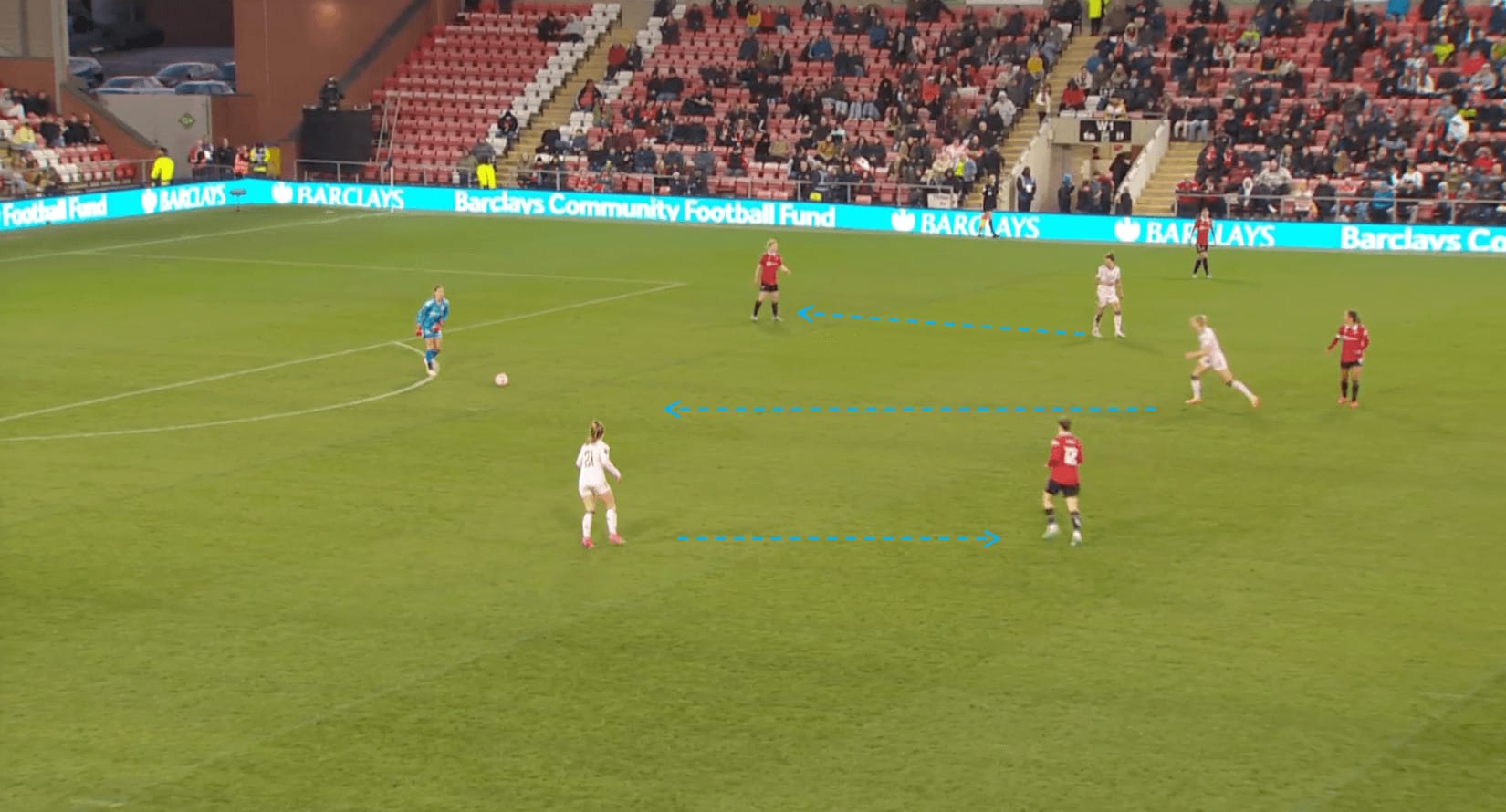
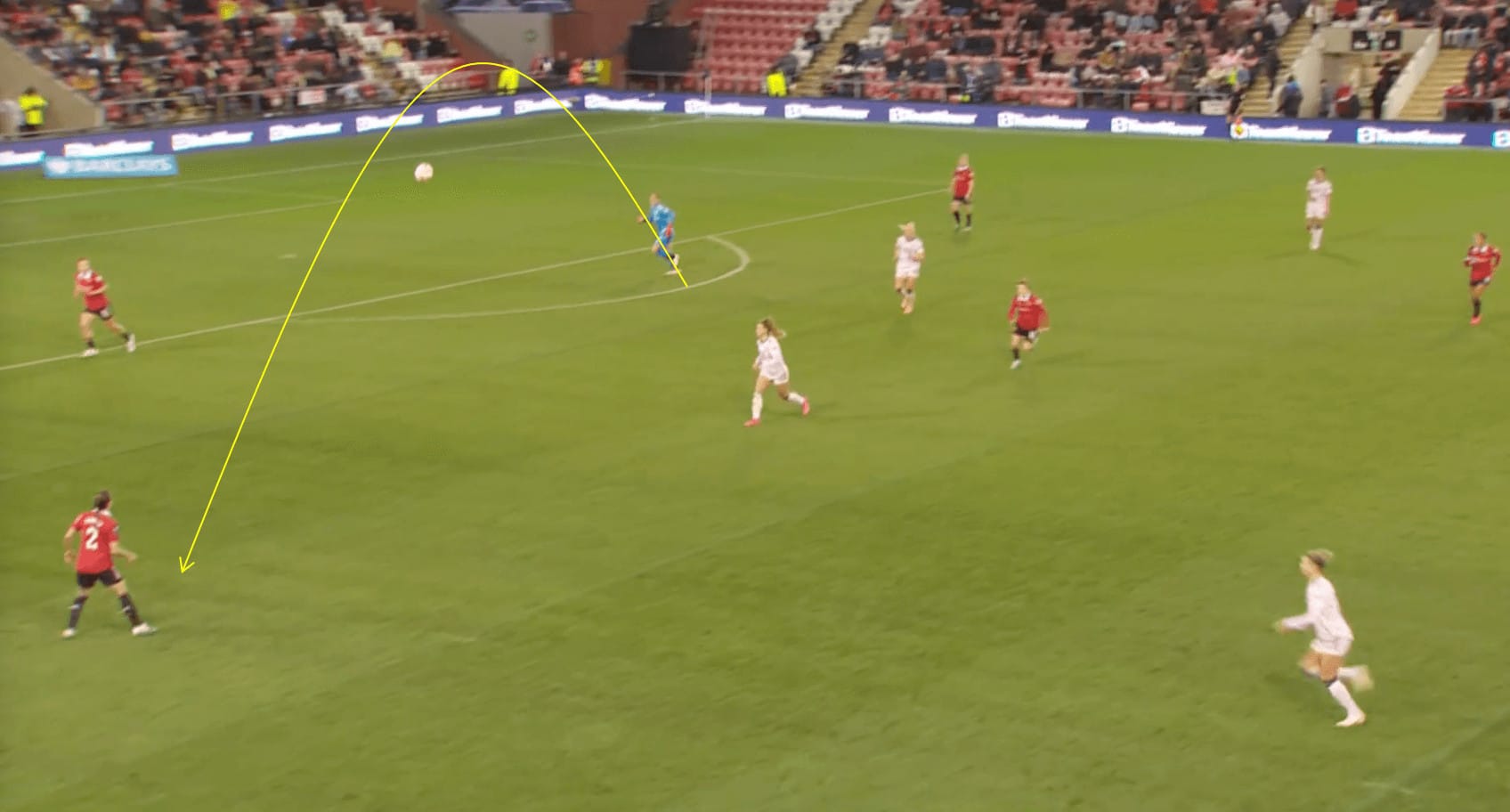
In this instance, Earps displays her ability to read the play well. She can see that Arsenal are looking to press her United teammates, which limits her options of playing a short pass. Instead, she sprays the ball out to Ona Batlle, who is free from an opponent and can look to build an attack.
Manchester United’s defensive unit
As mentioned in this scout report, it is essential to consider the effect that the defensive unit has on the goalkeeper’s performance. For example, Manchester United as a team conceded 7.5 shots against per 90, with only 2.37 of them requiring intervention from Earps. Therefore, we can infer that United’s defence did an excellent job of limiting the opportunities for opponents to generate high-quality shots.
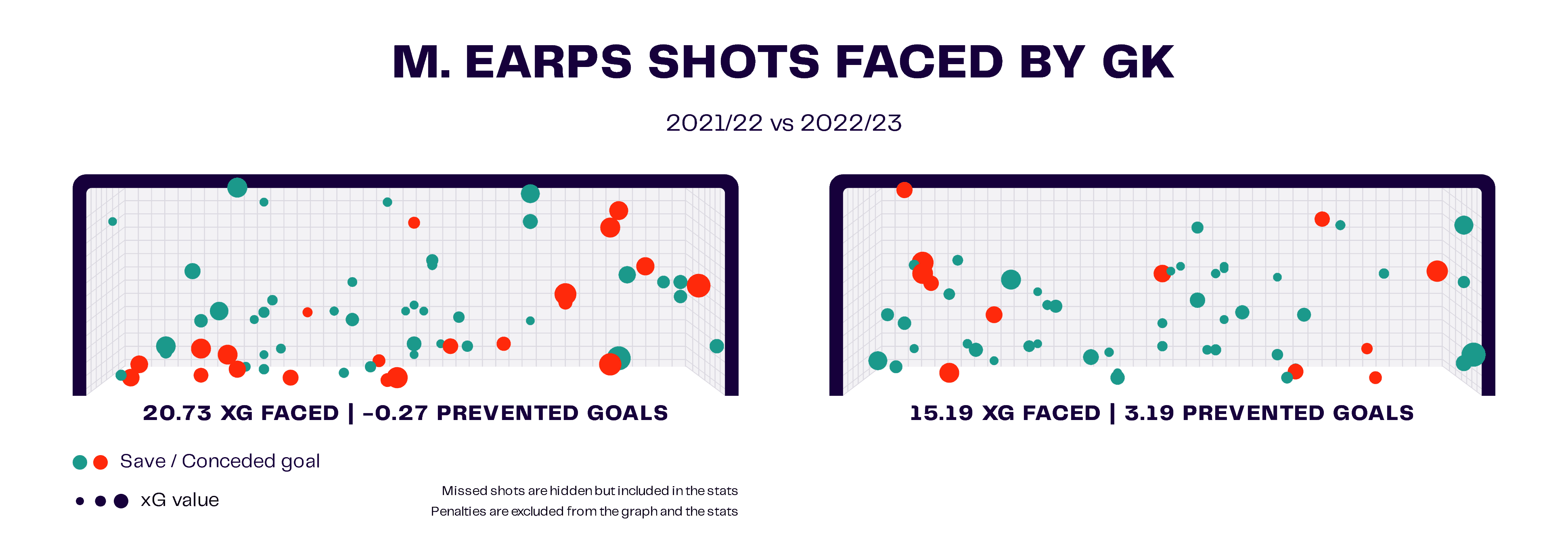
This is further supported by the visual above, which informs us that during the 2021/22 WSL season, Mary Earps faced an xG of 20.73 and conceded 0.27 more goals than expected. By comparison, as we have established, during the 2022/23 campaign, she faced an xG of 15.19 and prevented 3.19 goals. From this, we can understand that the defensive unit as a whole made significant improvements, and Mary Earps individually improved as a goalkeeper.
Additionally, it is worth noting that Marc Skinner’s team averaged 62.16% possession per 90 during 2022/23 compared to 56.42% in 2021/22. They were less likely to concede opportunities as they enjoyed more of the ball. Plus, in 2022/23, Man United had a PPDA of 6.34 compared to 7.34 in 2021/22, indicating they employed more of a high-pressing tactic, which saw them regain possession more speedily.
How does Phallon Tullis-Joyce compare to Mary Earps?
As many Manchester United Women’s fans will know, their number one goalkeeper has been the subject of endless transfer speculation, with Arsenal reportedly tabling a world record fee for a goalkeeper in the women’s game. However, with the North London team failing to qualify for this season’s Champions League, Earps is staying in Manchester, at least until January.
The shot-stopper’s contract runs out at the end of the season, and it currently appears unlikely that she will put pen to paper on an extension. Manchester United will want to avoid repeating what occurred with Alessia Russo – rejecting a world record bid only for her to leave for free six months later so the Red Devils may look to cash in on Earps in January.
Preempting the departure of his first-choice goalkeeper, Marc Skinner has been active in the summer window and acquired 26-year-old Phallon Tullis-Joyce from NWSL outfit OL Reign. In this section, we are going to compare the two goalkeepers to analyse their similarities and differences.
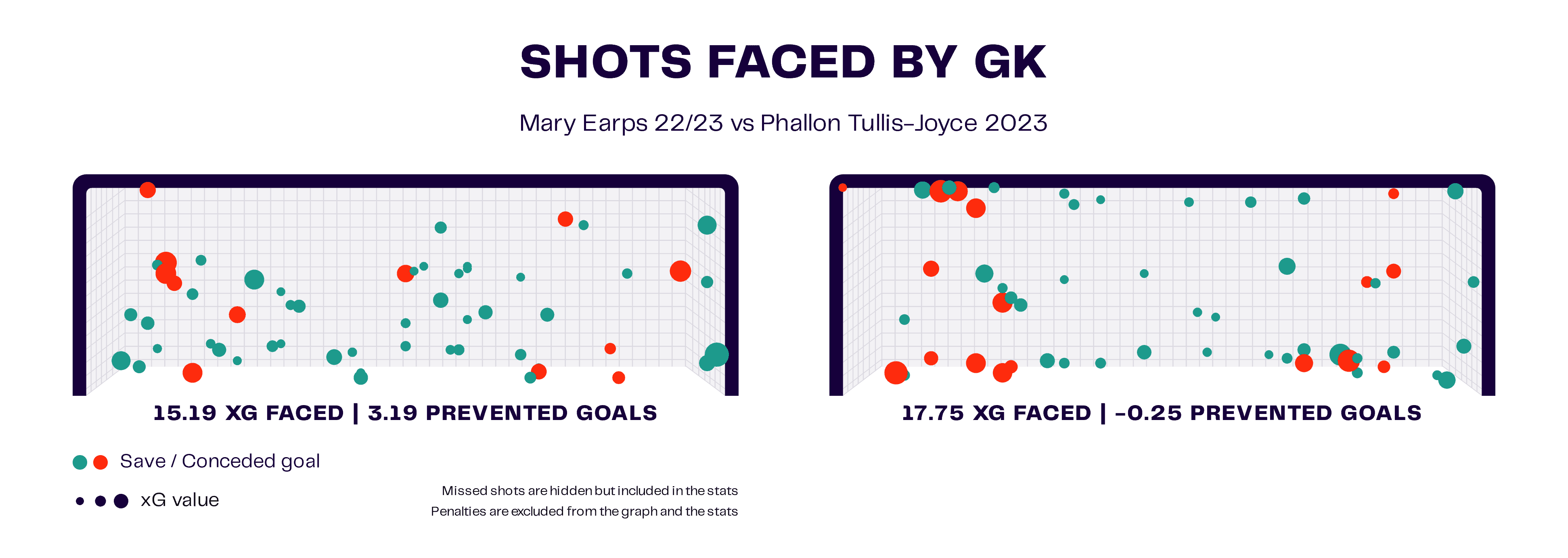
This data visual shows that Tullis-Joyce has conceded 0.25 more goals than expected during the 2023 NWSL campaign. However, if we turn our attention to the data visual below, it becomes clear that during the 2022 season, she faced a higher amount of xG but prevented a staggering 7.44 goals. So, once again, we have to consider that these stats are influenced by the performances of the defensive unit as a whole and the manager’s tactics.
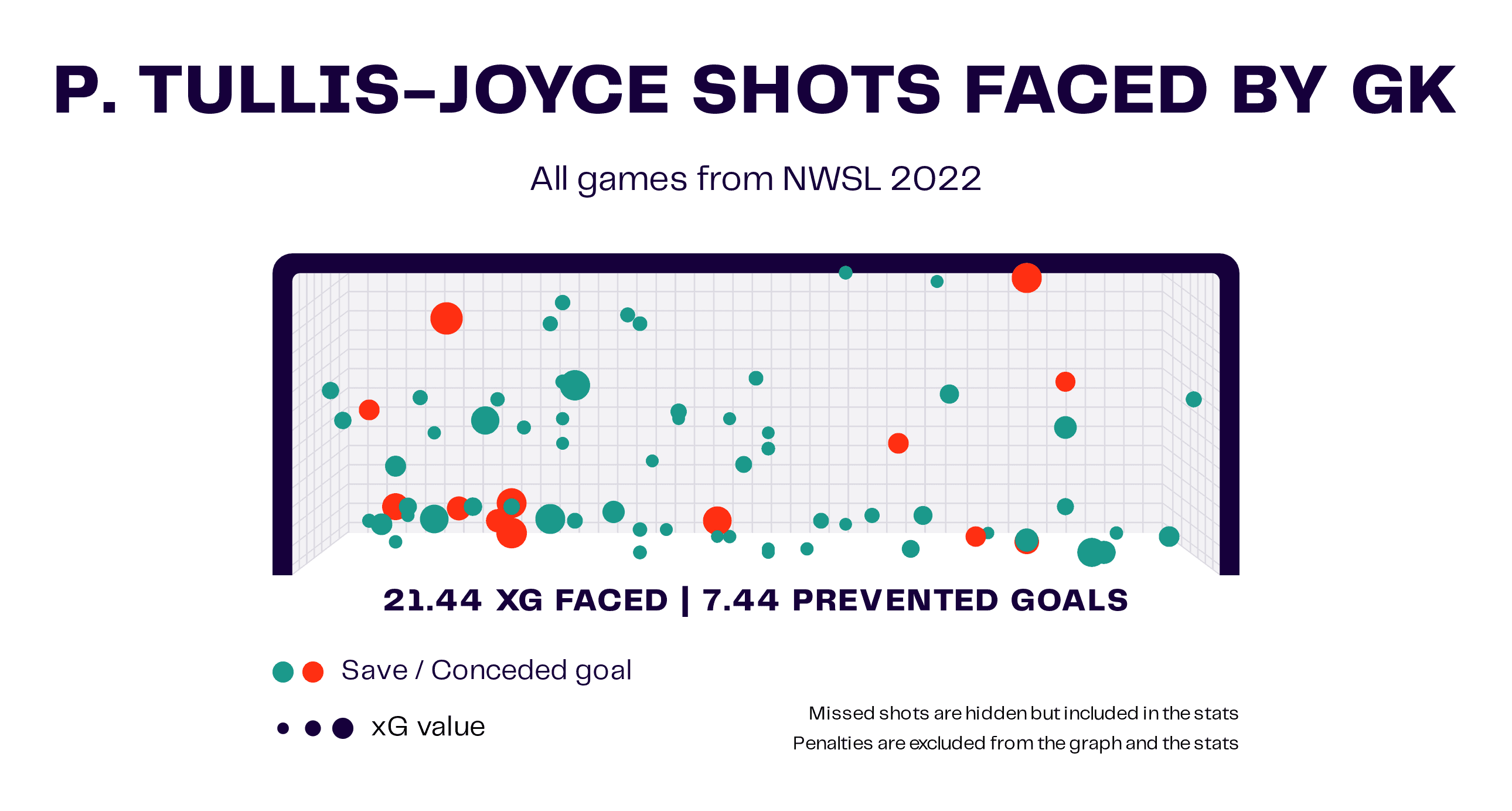
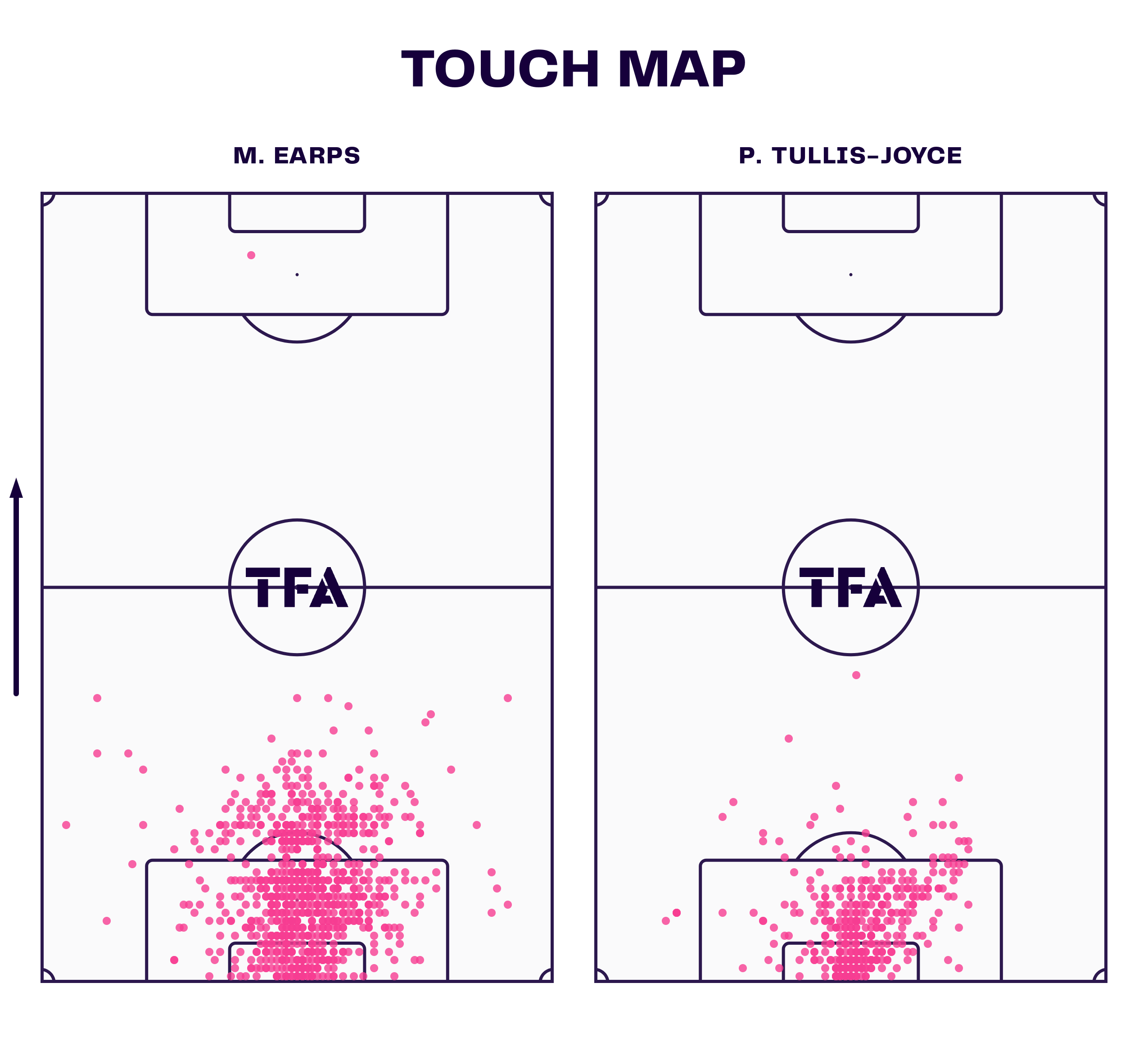
In this visual, we can see that Tullis-Joyce doesn’t touch the ball as often as Earps and also doesn’t move out of her area as often. One factor that may influence this is the amount of possession each team averages. As we know, Manchester United seek to dominate possession with over 60% possession per 90, with Earps often on hand to recycle the ball.
OL Reign has been averaging 48.12% possession per 90 during the 2023 season. With their opponents enjoying more of the ball, Tullis-Joyce has to be in the right position to limit goalscoring opportunities rather than leaving her area to build an attack. Additionally, this season, OL Reign’s PPDA is 9.2, indicating they do not counterpress to regain possession; therefore, Tullis-Joyce’s goal is more likely to become under threat.
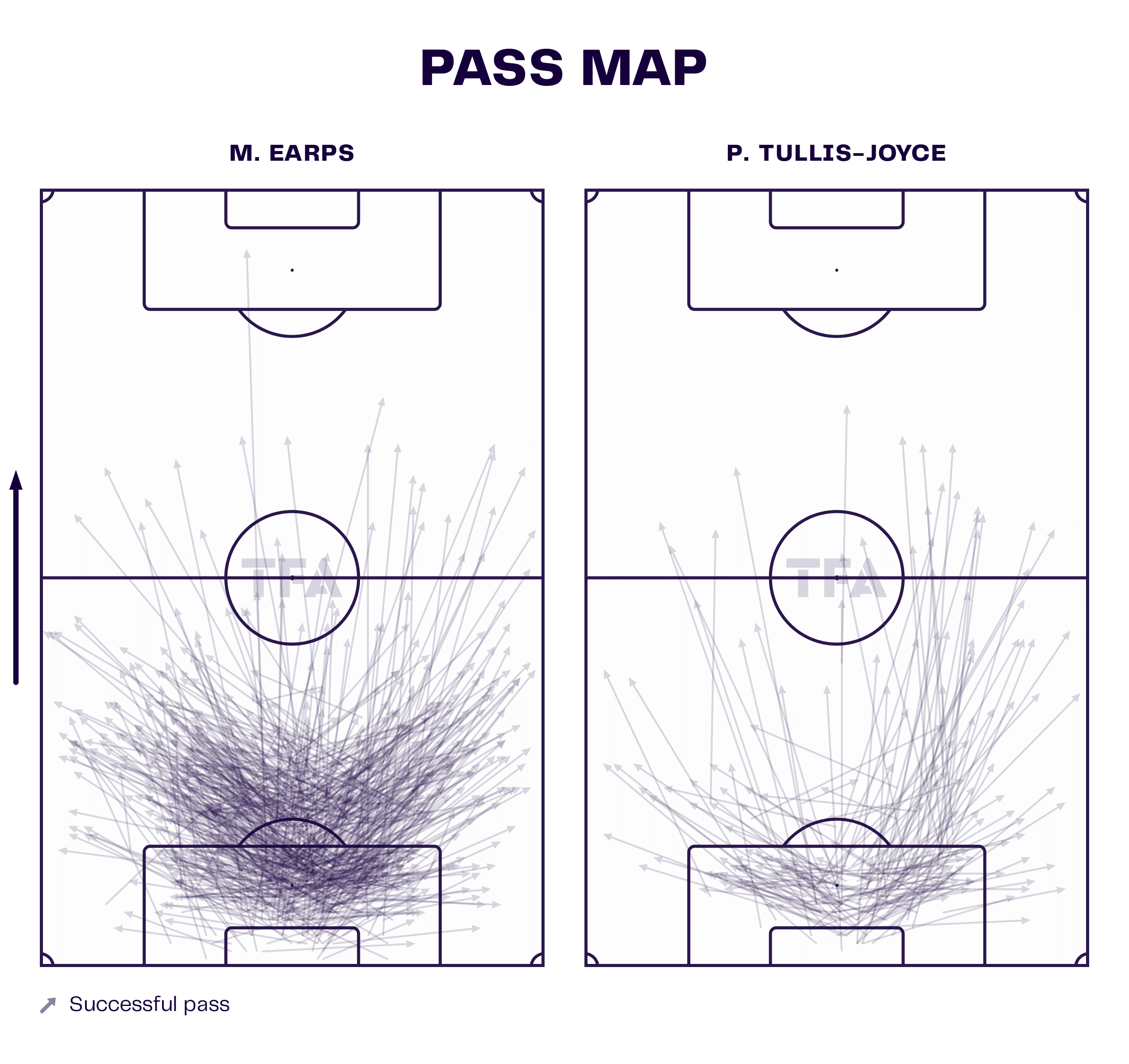
The pass maps indicate a vast difference in the number of passes made by the pair; Phallon Tullis-Joyce has been averaging 12.2 passes per 90 for OL Reign this season. Significantly lower than the 29.96 made by Mary Earps. Finally, based on the progressive passes made, Earps averaged 3.9 passes per 90 last season. It is worth noting that this is below average for the WSL but in keeping with Manchester United’s tactics. Meanwhile, her American counterpart has averaged 4.01 progressive passes per 90 in her 16 NWSL appearances this season but only 2.97 during the 2022 campaign.
Conclusion
Mary Earps has been a critical factor in Manchester United’s rise; she has been inspiring and given the team confidence to play their attacking football as they know they have a safe pair of hands in goal.
Even though it looks like her time in Manchester may be ending in January, the performances by Earps during the first half of the 23/24 campaign will go a long way to defining how well the Red Devils perform this season.
In preparation for her exit, Marc Skinner has brought in Phallon Tullis-Joyce, who is by no means a carbon copy of Earps but clearly is an outstanding goalkeeper and could ensure United don’t lose momentum should their current first-choice depart in the next transfer window.




Comments